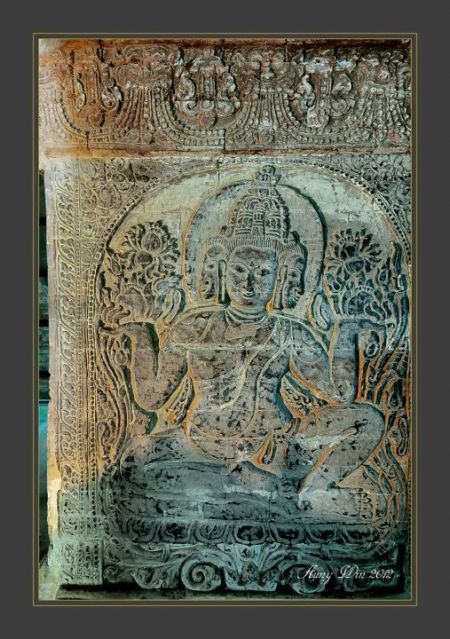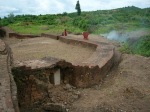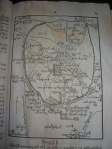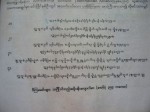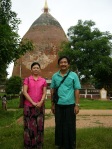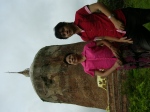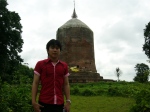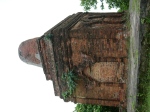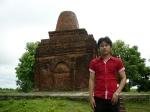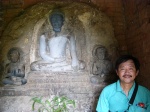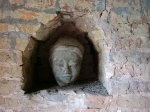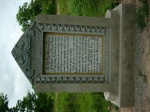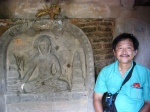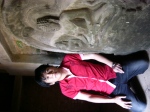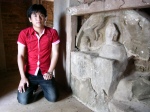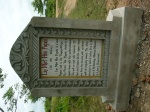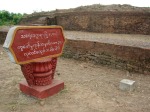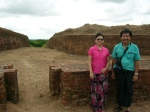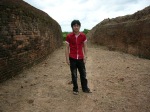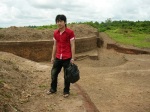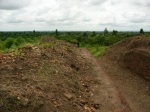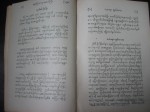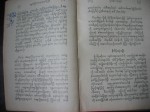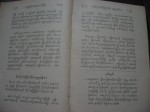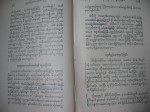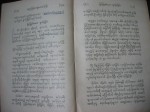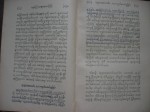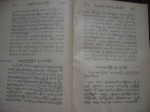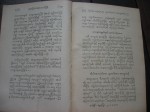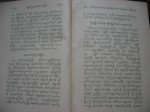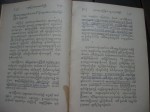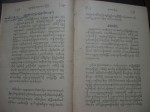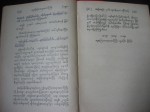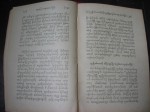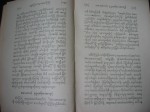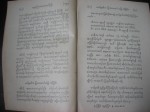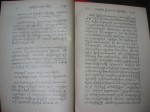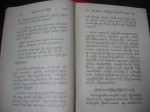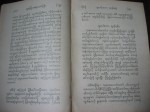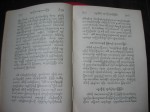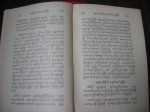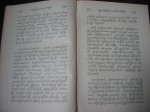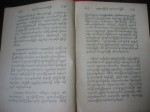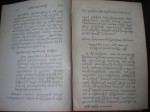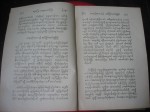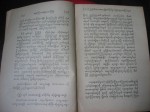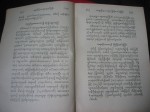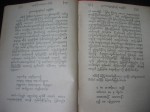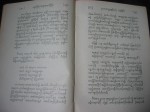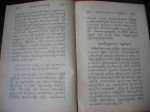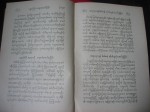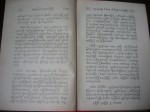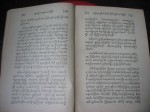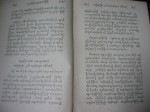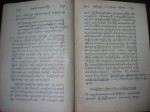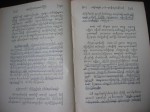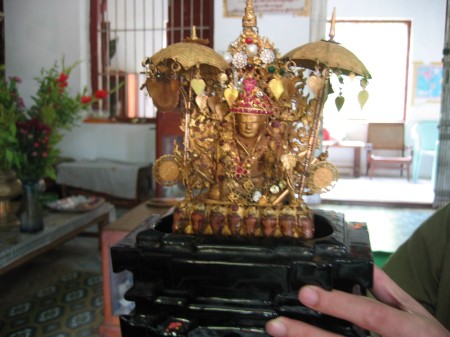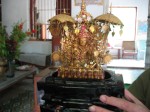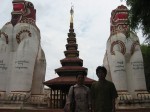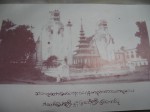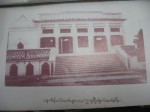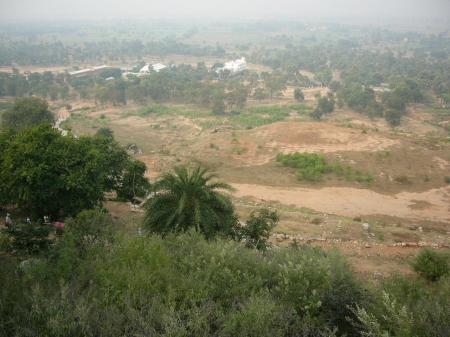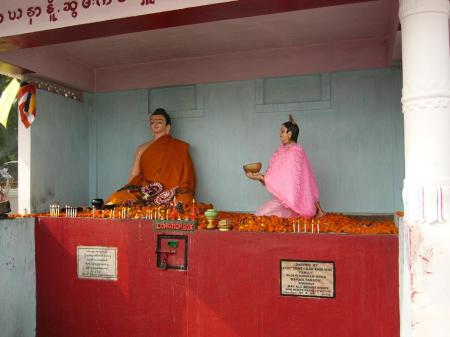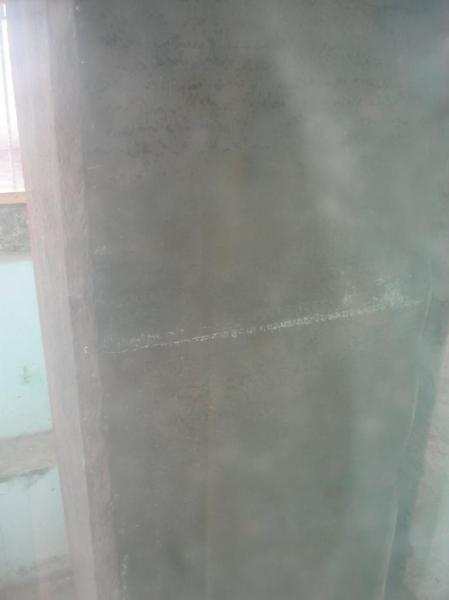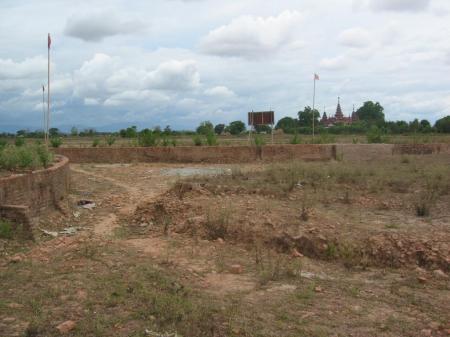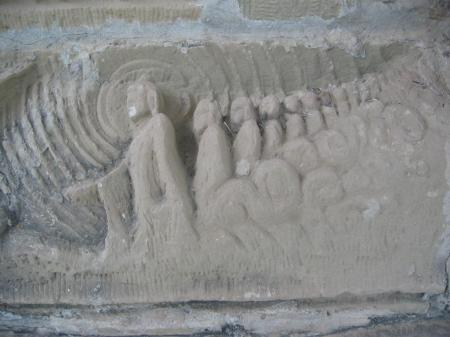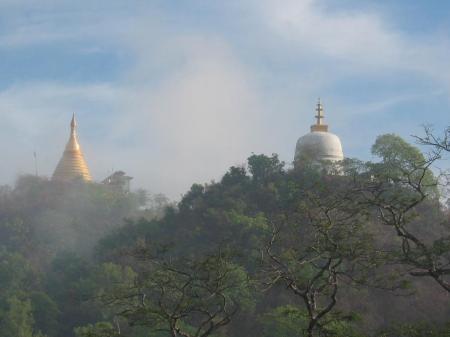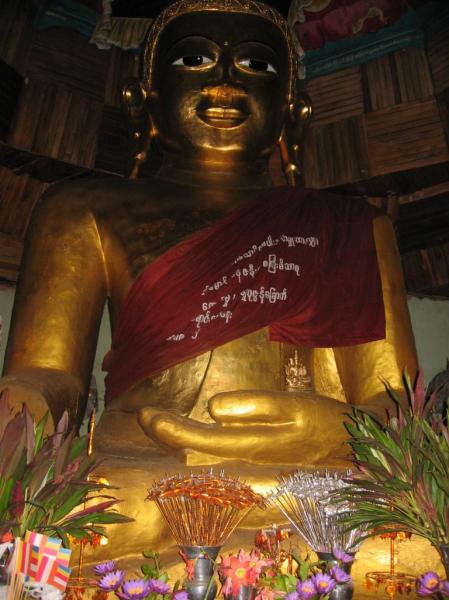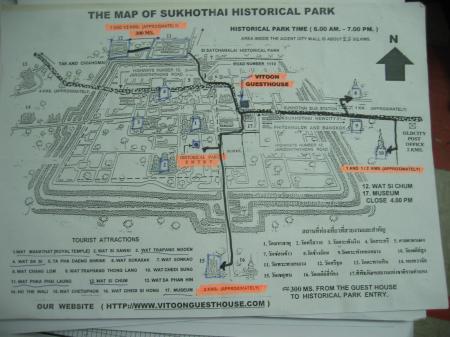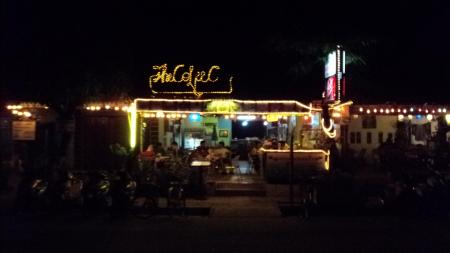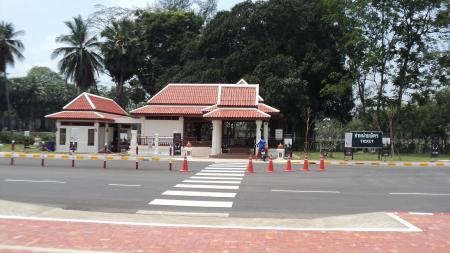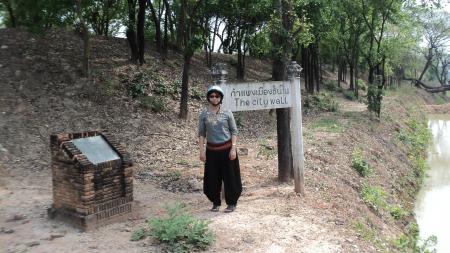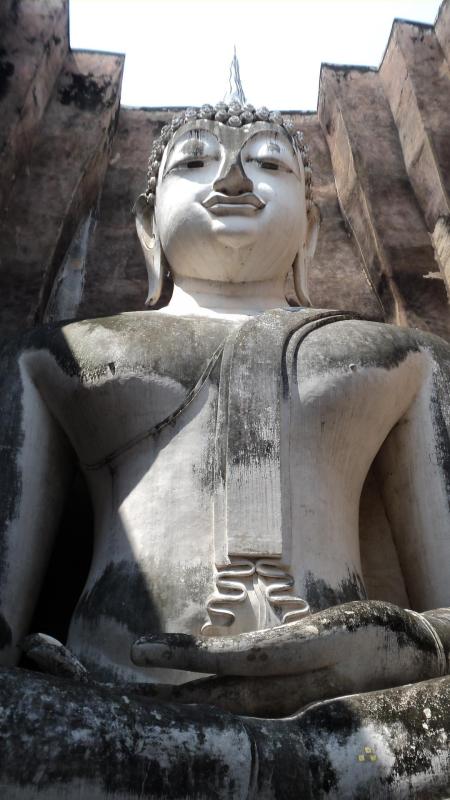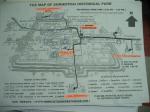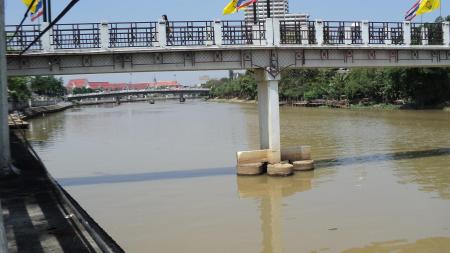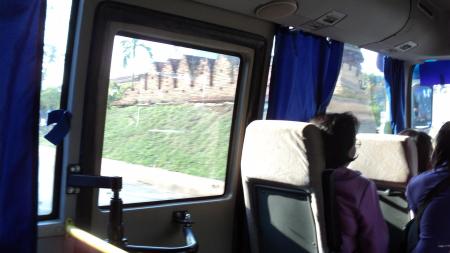International arms intervention in Burma is most crucial and inevitable
2011-03-02 |
|
| The Panglong Conference held on 12th February
1947, was an historic meeting that took place at Panglong in the Shan
States in Burma between the Shan, Kachin and Chin ethnic minority
leaders and general Aung San, head of the interim Burmese government. On
the agenda was the united struggle for independence from Britain and
the future of Burma after independence as a unified republic. The
agreement accepted “ Full autonomy in internal administration for the
frontier area”. Burma obtained independence on 4th, January, 1948. But the independent hero of Burma, general Aung San was assassinated by his military colleagues in 1947 just one year before the Independence. After the Independence the Democratic government of Burma was under pressure of ethnic minorities because they wanted the government to take measures to implement Panglong agreement. According to the agreement they deserved for autonomy. The U Nu government already discussed with the ethnic minorities including the Rohingya in Arakan and took positive steps to implement the Panglong agreement. Mayu Frontier in Arakan was declared for exclusively Rohingyas. But unfortunately General Ne Win leaded military seized power from him in 1962 and declined the PangLong agreement and as well as Mayu frontier. Since then the ethnic groups such as Karen, Shan, Kachin, etc., have been decided to accelerate their arms movement against military dictatorship, Ne Win and carrying on for about 50 years and the junta offending and retarding them inhumanely. Recently the ethnic Alliance vowed to strive for Federal Union ( Irrawaddy News ). The junta burnt many villages of ethnic minorities during wars. To evade persecution of junta thousands of Karen, Shan, Kachin, Rakhine, Rohingya , even Burman fled to near by countries to shelter as refugees. The ethnic minorities including Rohingyas are being faced racial and religious discrimination and junta introduced “divide and rule” policy in such areas. Junta rejected citizenship of Rohingyas by introducing citizenship Act-1982. Many times the military executed massacre across the country. Silent killing is a routine work of barbaric SPDC. Junta killed hundreds of ethnic people such as Karen, Shan etc were on way to nearby countries. The main opposition party NLD won the 1990 election. But junta denied to accept the result. Rather the elected parliamentary members including NLD chief Nobel laureate Daw Aung San Suukyi were put in jails for several years without proper allegations. The only political party ( NDPH ) of Rohingya Muslims which won 4 seats in 1990-election was banned and its chief Master Anowar (a ) Kyaw Man and his family members were imprisoned without judicial proceeding. As a Democratic reform amid international pressure, Junta trickfully held a general election in November,2010 in which the main opposition party, NLD was not allowed to contest and the symbolic opposition leader Daw Aung Suu Kyi was kept under house arrest. This election is only an eye wash. Junta was successful to organize some ethnic groups to vote SPDC by alluring in various ways. For example, in Arakan junta successfully organized the Rohingyas by alluring that they will be recognized as citizens of Burma and red cards ( National Cards) will be provided them and all the restrictions imposed on Rohingyas earlier will be lifted after election. That’s why the Rohingyas worked attentively for SPDC during the period of election campaign and voted in favour of SPDC. But after the election, no commitment of hypocrate junta is met, rather persecution on Rohingyas is intensifying more than ever caused the leaving of Rohingya youth for Malaysia by risky sea route is increasing more than ever. They are victims of inequality and in-justice. But they are compelled to shut mouth. Daw Aung San Suu Kyi was released after election. But she becomes like a boat without engine because her party, NLD is inactive and unable to revive due to imposing severe restriction on its activities. After the election persecution in the areas of revolutionary groups is significantly increased. That’s why the vulnerable 84,000 Karen people are going to summit a signed petition to the world leaders including Ban Ki Moon ( Irrawaddy News 28th February,2011) to take steps to protect them from the brutality of junta. The other ethnic minorities expressed their solidarity with this petition.The current popular uprising of Egypt impacted in other countries where the dictatorships have been sucking blood of general public for decades caused erupting war between the general public and the dictatorship in Libya and other nearby Arab countries. It is learnt that some western country are examining the need of arms intervention in Libya to protect the revolutionary people. International pressure on Muammar Qaddafi to end his crackdown on opponents escalated Monday as his loyalists closed in on rebel-held cities nearest the capital. The US moved naval and air forces closer to Libya and said all options were open, including the use of warplanes to patrol the North African nation’s skies and protect citizens threatened by their leader ( Arab News Feb.01.2011 ). However, Human Rights violation in Burma reached out of tolerance and the people of Burma are passing their life like prisoners and they have no guarantee of life. To erupt an uprising like the in-fructuous uprising1988 without international cooperation will never achieve the political goal. That’s why I believe that the only international arms intervention in Burma can de-root the tyrant military dictatorship and the political issue of Burma will be solved for ever. So, international arms intervention in Burma is most crucial and inevitable. References; *The Panglong Agreement, 1947 in Burmese and English inc. photos, New Era Journa *The Irrawaddy News ( February, 2011 publication ) *Arab News ( February 1, 2011 ) *Independence or Federalism Harn Yawnghwe, Chinland Guardian, April 9 2005
************************************
Nurul Islam | |
Tuesday, April 3, 2012
International arms intervention in Burma is most crucial and inevitable
Legislation Myanmar (Burma)
Nyiwin's Blog
Nyiwin's Blog
Just another WordPress.com weblog
Posts Tagged ‘infotainment’
Nann Phayarr နန္းဘုရား Myinkabar ျမင္းကပါ Bagan ပုဂံ
March 4, 2012
Nann Phayarr နန္းဘုရား at Myinkabar ျမင္းကပါ, Bagan ပုဂံ, near
the Manuha pagoda မႏူဟာ ဘုရား is one of the 3 sandstone pagodas of
Bagan. The others are the Shwesigone ေရႊစည္းခံု stupa and the KyauKuu
OoMin ေက်ာက္ကူး/ဂူ ဥမင္ temple at Nyaung Oo.
The Nann Phayarr နန္းဘုရား is built on the site where the king Manuha မႏူဟာမင္း of Thaton သထံု lived while as prisoner in exile in Bagan after he was defeated by king Anawratha အေနာ္ရထာ / အႏုရုဒၶာ.
The temple is quite small and has barred windows and is dark inside. The place is protected by the archeological department and the iron door is usually locked. Tourists are shown of the temple as there are interesting sculptures inside.
There are sandstone pillars with finely sculptured images of floral design ပန္းဆြဲ, ogre eating flower garland ဘီလူးပန္းကီုက္ and Lord Vishnu ဗိသႏိုးနတ္မင္း and is much appreciated by tourists, although most Myanmars do not know about it. Myanmars usually visit the Manuha မႏူဟာ pagoda with its enormous Buddha image in a narrow temple, representing the restricted situation of the king Manuha မႏူဟာ and went on elsewhere on pilgrimage.
The Nann Phayarr နန္းဘုရား is built on the site where the king Manuha မႏူဟာမင္း of Thaton သထံု lived while as prisoner in exile in Bagan after he was defeated by king Anawratha အေနာ္ရထာ / အႏုရုဒၶာ.
The temple is quite small and has barred windows and is dark inside. The place is protected by the archeological department and the iron door is usually locked. Tourists are shown of the temple as there are interesting sculptures inside.
There are sandstone pillars with finely sculptured images of floral design ပန္းဆြဲ, ogre eating flower garland ဘီလူးပန္းကီုက္ and Lord Vishnu ဗိသႏိုးနတ္မင္း and is much appreciated by tourists, although most Myanmars do not know about it. Myanmars usually visit the Manuha မႏူဟာ pagoda with its enormous Buddha image in a narrow temple, representing the restricted situation of the king Manuha မႏူဟာ and went on elsewhere on pilgrimage.
Tags:Bagan, Buddhism, Culture, history, infotainment, Myanmar, Travel
Posted in Travel, Culture, religion, Buddhism, history, Myanmar, Infotainment | Leave a Comment »
Posted in Travel, Culture, religion, Buddhism, history, Myanmar, Infotainment | Leave a Comment »
Shin Upagote ရွင္ဥပဂုတ္
March 4, 2012
Shin U Pa Gota, the “saint” of all waters. According to legend,
Shin U Pa Gota grew up a troubled boy until the Buddha visited him and
brought him instant enlightenment. From that moment, he spent his time
meditating in the Irrawaddy.
He is the saint of boatmen, of fishermen, of anyone who relies on the river.
The bamboo rafts with Shin U Pa Gota images are floated down the rivers during the monsoon and wherever the raft comes to shore it is greeted with huge reverence and a ceremony will be held. This will sometimes be just a day or maybe stretch into days.
Then, the villagers will set the raft loose so it can continue down the river, bringing blessings to the next village that takes it in.
Another legend is that this “arahat” Uppagutta was a diciple of Lord Buddha and was always late to take his lunch before noon.That is why his statue is always shown with the alms bowl in his hand and looking up to the sun to see whether it has passed the meridien.
The Burmese believe that Shin Upagote still lives in a floating brazen [brass] palace in the southern ocean, and that he too can be invoked to come by a prayer of special formula, and that his mere invisible presence will prevent storms and floods. Some believe also that he can be invoked when danger in the form of some physical violence threatens.
Shin Upagote {rhin U.pa.goat} seems to have been an entire creation of Mahayana Buddhism, unless he was the same monk as Moggaliputta-Tissa, who presided over the Third Buddhist [{p133}] Council, as some scholars would maintain. Shin Upagote was believed to have tamed the arch enemy of Buddhism, the great God Mara himself. Asoka was preparing to hold a great festival in honour of the religion, and the monks, realizing that God Mara would do everything in his power to destroy the festival, sent for Upagote. Upagote, by his miraculous powers, not only defeated Mara in a great struggle, but also converted him to Buddhism.
He is the saint of boatmen, of fishermen, of anyone who relies on the river.
The bamboo rafts with Shin U Pa Gota images are floated down the rivers during the monsoon and wherever the raft comes to shore it is greeted with huge reverence and a ceremony will be held. This will sometimes be just a day or maybe stretch into days.
Then, the villagers will set the raft loose so it can continue down the river, bringing blessings to the next village that takes it in.
Another legend is that this “arahat” Uppagutta was a diciple of Lord Buddha and was always late to take his lunch before noon.That is why his statue is always shown with the alms bowl in his hand and looking up to the sun to see whether it has passed the meridien.
The Burmese believe that Shin Upagote still lives in a floating brazen [brass] palace in the southern ocean, and that he too can be invoked to come by a prayer of special formula, and that his mere invisible presence will prevent storms and floods. Some believe also that he can be invoked when danger in the form of some physical violence threatens.
Shin Upagote {rhin U.pa.goat} seems to have been an entire creation of Mahayana Buddhism, unless he was the same monk as Moggaliputta-Tissa, who presided over the Third Buddhist [{p133}] Council, as some scholars would maintain. Shin Upagote was believed to have tamed the arch enemy of Buddhism, the great God Mara himself. Asoka was preparing to hold a great festival in honour of the religion, and the monks, realizing that God Mara would do everything in his power to destroy the festival, sent for Upagote. Upagote, by his miraculous powers, not only defeated Mara in a great struggle, but also converted him to Buddhism.
Tags:history, Culture, infotainment, religion, Buddhism, Myanmar
Posted in Buddhism, Culture, Festival, history, Infotainment, Life, Myanmar, religion | Leave a Comment »
Posted in Buddhism, Culture, Festival, history, Infotainment, Life, Myanmar, religion | Leave a Comment »
Pateikkayar ပဋိကၠရား
February 21, 2012
I have always known about Pateikkayar ပဋိကၠရား as mentioned in
the traditional Myanmar history and historical writings and also that
mentioned in the chronicles. The earliest mention of it I heard about is
during the time of king KyansitthaReign 1084–1113 when the prince of
Pateikkaya ပဋိကၠရား မင္းသား came to visit Bagan to meet princess Shwe
Ein The ေရႊအိမ္သည္ regularly. He came by flight due to the power of the
alchemist’s ball ျပဒါးလံုး he had in his mouth. The king was displeased
about their love because if they get married the country would come
under Indian rule. He arranged for the marriage of princess Shwe Ein The
ေရႊအိမ္သည္ to the son of king Sawlu. After the marriage, while the
prince of Pateikkaya ပဋိကၠရား was on the way to Bagan, he met Shin
Arahan during the flight and when he heard of the news of the marriage,
gave an exclamation. The alchemist’s ball ျပဒါးလံုး fell out of his
mouth and he dropped to the ground and died.
The next mention of Pateikkaya ပဋိကၠရား was during the time of king Narathu Reign 1167–1170. It is said that king Narathu does not use water after going to the toilet and because of this the Pateikkayar ပဋိကၠရား queen did not let him come near her. Narathu became angry and had her killed. Her father the king of Pateikkayar sent assassins in guise of Ponna soothsayers ပုဏၰား. When they were taken to the presence of the king, they assissanated Narathu. Hence, Narathu came to be called Kalakya Minn ကုလားက်မင္း / king who fell to Indians. There is another version of this episode, Narathu killed by the invading forces from the island country of Sri Lanka and the cause of the invasion being a trade restriction problem.
I also read about the fact that Pateikkaya ပဋိကၠရား was in present day Bangaladesh. Phayre “History” takes Pateikkaya ပဋိကၠရား as part of Bengal; Tun Nyein, followed by Gerini as Chittagong; Bhattasali as a ruined site in Patikkara pargana, Tippera district. An inscription of the Bagan places it west of Bagan. Hmannan makes it the southwest frontier of the Bagan kingdom. But Arakanese records, e.g. Do We, seem to use the word as a name of a king “Pateikkaya king of Marawa.” The location of Marawa is equally conjectural. Do We, in a variant of of the Lady of Pateikkaya story, says she was captured by a king of Bagan while travelling at Thingadaung pass in the Yomadaung, i.e. in a hill country. San Shwe Bu thinks Thingadaung pass is north of Mount Victoria and Marawa to be Mawyin, the Kabaw valley; if so, Pateikkaya is near south Manipur.
Here are more about Pateikkaya ပဋိကၠရား
http://en.wikipedia.org/wiki/Anawrahta
Anawrahta also received tribute from the Buddhist kingdom of Pateikkaya (ပဋိကၠရား, IPA: [bədeiʔ kʰəjá]). The location of the small kingdom remains in dispute. The Burmese chronicles report the location as northwest of Arakan and its kings Indian.[21] But British historian GE Harvey reckoned that it was more likely nearer to the eastern Chin Hills.[22]
http://en.wikipedia.org/wiki/Shwe_Einthi
Shwe Einthi (Burmese: ေရႊအိမ္သည္, pronounced [ʃwè ʔèiɴðì]; also Shwe Einsi, [ʃwè ʔèiɴzì]) was a princess of Pagan Dynasty of Burma (Myanmar). She was the only daughter of King Kyansittha (r. 1084–1113), and the mother of King Alaungsithu (r. 1113–1167).[1]
The princess is best remembered in Burmese history for her failed love affair with the prince of Pateikkaya, a kingdom, believed to be in East Bengal or in eastern Chin Hills.[2] Soon after her father became king in 1084, she fell in love the prince who was visiting Pagan. But her father forbade her to marry a foreigner, and instead married her off to Prince Sawyun, the son of the late King Sawlu. The primate of Pagan Shin Arahan broke the news to the prince, who subsequently committed suicide.[1][3]
The princess had two children with Sawyun: Soe Saing, and Sithu, who succeeded Kyansittha.
http://en.wikipedia.org/wiki/Narathu
Narathu’s reign came to an abrupt end in 1170 when the king was killed by the mercenaries sent by the chief of Pateikkaya, a tributary kingdom in the west (near or today’s Chin State). The reason was to avenge for Narathu’s murder of the chief’s daughter, whom the chief had sent to Narathu as tribute. Narathu did raise the chief’s daughter as queen but killed her with his own hands in one of his episodes of violence.
http://en.wikipedia.org/wiki/Chin_State
The first recorded instance of a western kingdom believed to be near the Chin Hills is the Kingdom of Pateikkaya, a tributary to the Pagan Kingdom in the 11th and 12th centuries. Some historians (Arthur Phayre, Tun Nyein) put Pateikkaya in eastern Bengal, thus placing the entire Chin Hills under Pagan suzerainty but others like Harvey, citing stone inscriptions, put it near eastern Chin Hills.[4] (Burmese Chronicles report the kings of Pateikkaya as Indian though the ethnicity of the subjects is not explicitly cited.)
http://www.asiaexplorers.com/myanmar/dhammayangyi_pahto.htm
Dhammayangyi Temple was built by King Narathu, who killed his father King Alaungsithu and proclaimed himself king in 1167 AD. Concerned for his karma for having murdered his father, King Narathu built the Dhammayangyi Temple to atone for his misdeed. Narathu himself oversaw the construction of Dhammayangyi. He would have the masons executed if a needle could be pushed between the bricks that they laid.
Still, Narathu never saw the temple to its completion, for he himself was assassinated. This was that had happened. Narathu had taken one of his father’s wives as his own. This wife was an Indian princess from Pateikkaya. Displeased with her Hindu customs, he had her executed. In revenge, her father sent eight men disguised as Brahmans to Bagan. When King Narathu received them, they drew swords and killed him. Thereupon, the men committed suicide.
http://myanmartravelinformation.com/bagan-where-to-visit/dhammayangyi-temple.htm
History
After murdering his own king father, Narathu ascended the throne of Bagan and due to that, he built this temple. It is said that Narathu oversaw the construction himself and that masons were excecuted if a needle could be pushed between bricks they had laid. But he never completed the construction because he was assassinated before the completion. It was said that he was displeased by the Hindu rituals and one of them who made those rituals was the Indian princess who was the daughter of Pateikkaya. So he executed her for such reasons. The princess’s father wanted revenge for his innocent daughter and sent 8 officers in the disguise of Brahmans and assassinated Narathu in this very temple.
http://www.nagajournal.com/articles/letter-of-greetings-to-all-the-nagas-from-forgotten-offspring/5004
The first recorded instance of a western kingdom believed to be near the Chin Hills is the Kingdom of Pateikkaya in the 11th and 12th centuries. Some historians (Arthur Phayre, Tun Nyein) put Pateikkaya in eastern Bengal, thus placing the entire Chin Hills under Pagan suzerainty but others like Harvey, citing stone inscriptions, put it near eastern Chin Hills. (Burmese Chronicles report the kings of Pateikkaya as Indian though the ethnicity of the subjects is not explicitly cited.)
Maung Nyo Dear Dr Nyi Win, Splendid! I read in Bangladeshi History that Pateikaya was in the Eastern Bengal ruled by Buddhist kings of Pallawa descents. Read history writings from Bangladesh.
Maung Nyo Another thing, Missagiri was ruled by the Pagan Kings and it was the old name of the Chin hills.
Alfred Balwin Thanks Ko Nyi Win. I think Prince Pateikkayar must be a Hindu because he depends on Alchemist’s Ball. If he is a Muslim, he will used a Magic Carpet by mean of long distance traveling and more safe. Anyway, I love reading Myths, Legends and History. We see a lot of Prince, Princess and Wannabe in modern days of Myanmar.
Maung Nyo Dear Alfred, Prince PateikpayaBuddhist because he was a friend of Shin Arahan and his Kingdom was Buddhist at the time, Pallawa Dynasty.
Harry Hpone Thant On the banks of the Ayeyarwady River a little above Sinbaung wei(ဆင္ေပါင္ဝဲ) there is a curious rock formation. Locals call it ေက်ာက္ေသတၱာ and say it was the place where this Pateik kaya fell down from the sky and died!
Harry Hpone Thant And at a village near this town is where Shweman Tin maung collapsed on the stage while dancing. But I forgot the name of the village. It is a big village and engaged in weaving. The pagoda there has 4 entrances and nobody dare use the entrance facing the river. Supersition says if somebody tries to cross the river opposite this entrance they will die or the boat capsize and also no birds will fly into the pagoda from this entrance. It was at this pagoda festival that Shweman Tin Maung died
The next mention of Pateikkaya ပဋိကၠရား was during the time of king Narathu Reign 1167–1170. It is said that king Narathu does not use water after going to the toilet and because of this the Pateikkayar ပဋိကၠရား queen did not let him come near her. Narathu became angry and had her killed. Her father the king of Pateikkayar sent assassins in guise of Ponna soothsayers ပုဏၰား. When they were taken to the presence of the king, they assissanated Narathu. Hence, Narathu came to be called Kalakya Minn ကုလားက်မင္း / king who fell to Indians. There is another version of this episode, Narathu killed by the invading forces from the island country of Sri Lanka and the cause of the invasion being a trade restriction problem.
I also read about the fact that Pateikkaya ပဋိကၠရား was in present day Bangaladesh. Phayre “History” takes Pateikkaya ပဋိကၠရား as part of Bengal; Tun Nyein, followed by Gerini as Chittagong; Bhattasali as a ruined site in Patikkara pargana, Tippera district. An inscription of the Bagan places it west of Bagan. Hmannan makes it the southwest frontier of the Bagan kingdom. But Arakanese records, e.g. Do We, seem to use the word as a name of a king “Pateikkaya king of Marawa.” The location of Marawa is equally conjectural. Do We, in a variant of of the Lady of Pateikkaya story, says she was captured by a king of Bagan while travelling at Thingadaung pass in the Yomadaung, i.e. in a hill country. San Shwe Bu thinks Thingadaung pass is north of Mount Victoria and Marawa to be Mawyin, the Kabaw valley; if so, Pateikkaya is near south Manipur.
Here are more about Pateikkaya ပဋိကၠရား
http://en.wikipedia.org/wiki/Anawrahta
Anawrahta also received tribute from the Buddhist kingdom of Pateikkaya (ပဋိကၠရား, IPA: [bədeiʔ kʰəjá]). The location of the small kingdom remains in dispute. The Burmese chronicles report the location as northwest of Arakan and its kings Indian.[21] But British historian GE Harvey reckoned that it was more likely nearer to the eastern Chin Hills.[22]
http://en.wikipedia.org/wiki/Shwe_Einthi
Shwe Einthi (Burmese: ေရႊအိမ္သည္, pronounced [ʃwè ʔèiɴðì]; also Shwe Einsi, [ʃwè ʔèiɴzì]) was a princess of Pagan Dynasty of Burma (Myanmar). She was the only daughter of King Kyansittha (r. 1084–1113), and the mother of King Alaungsithu (r. 1113–1167).[1]
The princess is best remembered in Burmese history for her failed love affair with the prince of Pateikkaya, a kingdom, believed to be in East Bengal or in eastern Chin Hills.[2] Soon after her father became king in 1084, she fell in love the prince who was visiting Pagan. But her father forbade her to marry a foreigner, and instead married her off to Prince Sawyun, the son of the late King Sawlu. The primate of Pagan Shin Arahan broke the news to the prince, who subsequently committed suicide.[1][3]
The princess had two children with Sawyun: Soe Saing, and Sithu, who succeeded Kyansittha.
http://en.wikipedia.org/wiki/Narathu
Narathu’s reign came to an abrupt end in 1170 when the king was killed by the mercenaries sent by the chief of Pateikkaya, a tributary kingdom in the west (near or today’s Chin State). The reason was to avenge for Narathu’s murder of the chief’s daughter, whom the chief had sent to Narathu as tribute. Narathu did raise the chief’s daughter as queen but killed her with his own hands in one of his episodes of violence.
http://en.wikipedia.org/wiki/Chin_State
The first recorded instance of a western kingdom believed to be near the Chin Hills is the Kingdom of Pateikkaya, a tributary to the Pagan Kingdom in the 11th and 12th centuries. Some historians (Arthur Phayre, Tun Nyein) put Pateikkaya in eastern Bengal, thus placing the entire Chin Hills under Pagan suzerainty but others like Harvey, citing stone inscriptions, put it near eastern Chin Hills.[4] (Burmese Chronicles report the kings of Pateikkaya as Indian though the ethnicity of the subjects is not explicitly cited.)
http://www.asiaexplorers.com/myanmar/dhammayangyi_pahto.htm
Dhammayangyi Temple was built by King Narathu, who killed his father King Alaungsithu and proclaimed himself king in 1167 AD. Concerned for his karma for having murdered his father, King Narathu built the Dhammayangyi Temple to atone for his misdeed. Narathu himself oversaw the construction of Dhammayangyi. He would have the masons executed if a needle could be pushed between the bricks that they laid.
Still, Narathu never saw the temple to its completion, for he himself was assassinated. This was that had happened. Narathu had taken one of his father’s wives as his own. This wife was an Indian princess from Pateikkaya. Displeased with her Hindu customs, he had her executed. In revenge, her father sent eight men disguised as Brahmans to Bagan. When King Narathu received them, they drew swords and killed him. Thereupon, the men committed suicide.
http://myanmartravelinformation.com/bagan-where-to-visit/dhammayangyi-temple.htm
History
After murdering his own king father, Narathu ascended the throne of Bagan and due to that, he built this temple. It is said that Narathu oversaw the construction himself and that masons were excecuted if a needle could be pushed between bricks they had laid. But he never completed the construction because he was assassinated before the completion. It was said that he was displeased by the Hindu rituals and one of them who made those rituals was the Indian princess who was the daughter of Pateikkaya. So he executed her for such reasons. The princess’s father wanted revenge for his innocent daughter and sent 8 officers in the disguise of Brahmans and assassinated Narathu in this very temple.
http://www.nagajournal.com/articles/letter-of-greetings-to-all-the-nagas-from-forgotten-offspring/5004
The first recorded instance of a western kingdom believed to be near the Chin Hills is the Kingdom of Pateikkaya in the 11th and 12th centuries. Some historians (Arthur Phayre, Tun Nyein) put Pateikkaya in eastern Bengal, thus placing the entire Chin Hills under Pagan suzerainty but others like Harvey, citing stone inscriptions, put it near eastern Chin Hills. (Burmese Chronicles report the kings of Pateikkaya as Indian though the ethnicity of the subjects is not explicitly cited.)
Maung Nyo Dear Dr Nyi Win, Splendid! I read in Bangladeshi History that Pateikaya was in the Eastern Bengal ruled by Buddhist kings of Pallawa descents. Read history writings from Bangladesh.
Maung Nyo Another thing, Missagiri was ruled by the Pagan Kings and it was the old name of the Chin hills.
Alfred Balwin Thanks Ko Nyi Win. I think Prince Pateikkayar must be a Hindu because he depends on Alchemist’s Ball. If he is a Muslim, he will used a Magic Carpet by mean of long distance traveling and more safe. Anyway, I love reading Myths, Legends and History. We see a lot of Prince, Princess and Wannabe in modern days of Myanmar.
Maung Nyo Dear Alfred, Prince PateikpayaBuddhist because he was a friend of Shin Arahan and his Kingdom was Buddhist at the time, Pallawa Dynasty.
Harry Hpone Thant On the banks of the Ayeyarwady River a little above Sinbaung wei(ဆင္ေပါင္ဝဲ) there is a curious rock formation. Locals call it ေက်ာက္ေသတၱာ and say it was the place where this Pateik kaya fell down from the sky and died!
Harry Hpone Thant And at a village near this town is where Shweman Tin maung collapsed on the stage while dancing. But I forgot the name of the village. It is a big village and engaged in weaving. The pagoda there has 4 entrances and nobody dare use the entrance facing the river. Supersition says if somebody tries to cross the river opposite this entrance they will die or the boat capsize and also no birds will fly into the pagoda from this entrance. It was at this pagoda festival that Shweman Tin Maung died
The 2 versions of how Sriksetra / ThaRay Khittayar was built and the questions and thoughts that come to my mind
June 16, 2011
There are mythological facts about the establishment of Sriksetra / ThaRayKhittayar the ancient Pyu walled city near Pyay (Pyay means country in Myanmar and the current city of Pyay or the Sriksetra / ThaRayKhittayar nearby was considered as their former country by those who left Sriksetra / ThaRayKhittayar after its fall and settled in Yonehlutkyunn which became the first Bagan and the place is still being called as such) as being told traditionally and mentioned in Myanmar Chronicles including the Glass Palace Chronicle / HmanNann Yarzawin.
I do not know what the current official version of the event is but
this version is still being mentioned in Dr. Thet Tin’s recently
published book. However, I also read of another version of the
construction of Sriksetra / ThaRayKhittayar from contemporary Pyu writings in the late Dr. Than Tun’s book Khit Haung Myanmar Yarzawin.
The origin of Sriksetra / ThaRayKhittayar is clouded in mystery with mythological events recorded in Myanmar Chronicles and oral traditions, and an entirely different version recorded in Pyu inscription which mentioned about how it was built. I do not know what the current official version of the event is but I heard of the first traditional version while I was young and read about it from the Glass Palace Chronicle / HmanNann Yarzawin and read about the second Pyu version from Dr. Than Tun’s books.
The Glass Palace Chronicle / HmanNann Yarzawin version
When King Maha ThamBaWa died after 6 years’ reign at Sakya Inn, his younger brother Sula ThamBaWa became king in the year BE 66 / 478 BC and made the former queen Baydaryi who was 3 months pregnant with DutTaBaung his queen. King Sula ThamBaWa died after 35 years of good reign in the year BE 101 / 513 BC and DutTaBaung became king and established Sriksetra / ThaRayKhittayar.
7 persons including the Gawun Pathe Rathe, ThaGyar Minn, Nagarr, Galon discussed and helped build the city according to Buddha’s prophecy. ThaGyarMinn / king of the TharWaTeinThar Nat Pyay / celestial abode / Moe Nat Minn stood on the central post of the good and even land and made a circle with the Nagarr / serpent / dragon as a rope and the resulting city of Sriksetra / ThaRayKhittayar was of 1 Yuzanar diameter, 3 Yuzanar circumference with the 7 city features of 32 large gates, 32 small entrances, moat, drains, PyitSin, YinShauk, Tazaung, PyaOe. There were also 3 palaces with PyatThats of 7, 9 and 11 Bon for the Hot, Rainy and Cold 3 seasons built by Nats. The city was built within 7 days and the ThaGyar Minn coronated DutTaBaung with 5 kingly apparels including the Thilawun sword and various apparels of emperors, the AhReinDhamar lance, big bell and drum, the Narlar Giri elephant of 22 ft height and 30 ft length and the WaLar Haka horse that can bear the king, 27 Nat warriors to protect the king, the minister NgaNi Parr, NgaYe Kyarr, Pazin Phyu, Pazin Nyo who are well versed in diplomacy and intelligence.
King DutTaBaung was a very powerful king and whenever he walked, the earth gave way and the ThaGyar Minn had iron mushrooms placed where he will step. The whole world including the ZamBu DiPar Kyun, AhThuYar country and Nagarr country had to offer tribute and give tax.
Although not included in the Glass Palace Chronicle / HmanNann Yarzawin the oral tradition also mentioned that while making a circle to mark the boundry of Sriksetra / ThaRayKhittayar, the Nagarr drew back twice when it met Galon (Nagarr and Galon are natural enemies with the Galon having the upper hand, although the Glass Palace Chronicle / HmanNann Yarzawin mentioned that both the Nagarr and Galon helped the Gawun Pathe Rathe and the ThaGyar Minn in building Sriksetra / ThaRayKhittayar). Hence the city wall is not circular but uneven at 2 places.
It is difficult to believe that the ThaGyarMinn / king of the TharWaTeinThar Nat Pyay / celestial abode / Moe Nat Minn actually helped king DutTaBaung but I have heard of explanation about the traditional Myanmar oral and chronicle version as follows:
The Kathit pole (ThagyarMinn) is used as centre point to draw the circle using cow (Nagarr) hide string and as there were ponds / Aing (Galon) where the wall cannot be constructed and therefore moved a little to the edge of the ponds and hence the city wall is not circular.
However, on aerial photo view, the city wall is not actually circular and there are no definite deviations at the northeast where the PaukKhaung road leaves the city wall, which is the NagaTunt.
Version from Pyu inscription (Dr. Than Tun’s KhitHaung Yarzawin)
The Pyu king / Dube HaRi WiKraMa built the city of Sriksetra / ThaRayKhittayar. (According to Dr. Than Tun, DutTaBaung is not the name of a king but a changed version for the Pyu word for king_ Dube)
Pyu inscription found at Hmawzar WutKhaung hill:
The inscription records the facts concerning the sculpturing of the Buddha statute on order of prince ZaYa Sandra Varman.
The first verse records the building of the 2 cities (1 seems to be Sriksetra / ThaRay Khittayar) on the same day and the preaching by the prince ZaYa Sandra Varman’s abbot GuHa / GuHa DiPa
The younger brother HaRi WiKraMa (seems to be the ruler of 1 of the 2 cities mentioned) also contributes to the good deed / donation.
The 2 brothers and the people of the 2 cities became friendlier due to the abbot.
The 5th stanza mentioned that the future citizens of the 2 cities would also be friendly with each other.
The last verse prayed for the friendship of the 2 cities till the end of the world and for the successors of the younger brother.
Dikshit’s (who read the inscription) comments:
Although HaRi WiKraMa is mentioned as younger brother, it should not be taken as they are blood brothers but as the younger of the 2 kings
There was a feud between the 2 which was mediated by the abbot GuHa DiPa
The facts that ZaYa Sandra Varman had to contribute the Buddha statute and the well being of HaRi WiKraMa was wished for indicates that HaRi WiKraMa has the upper hand and ZaYa Sandra Varman is in subordinate alliance
Of the 2 kings, the younger HaRi WiKraMa is stronger and would likely to be the one who build the big city of Sriksetra / ThaRay Khittayar in the 4th century AD. If 1 of the 2 cities is Sriksetra / ThaRay Khittayar, which is the other one? It cannot be Beikthanoe which is muh older than Sriksetra / ThaRay Khittayar.
If HaRi WiKraMa established Sriksetra / ThaRay Khittayar, the WiKraMa dynasty would have ruled it. This is borne out by the finding of names of 3 kings ending with WiKraMa in the rock funeral urns: HaRi WiKraMa, TiHa WiKraMa and Thuriya WiKraMa.
The mention of prince ZaYa Sandra Varman in the Pyu inscription and also the fact that there was a feud between HaRi WiKraMa and ZaYa Sandra Varman is very interesting.
A 5th century AD Pyu inscription on the silver Bhodi throne found at Khin Ba hill mentioned the names of the 2 donors Sri Pra Bu WarMa and Sri Pra Bu Devi. The Varman / WarMa at the end of the king’s name is interesting.
There are kings whose names ends with Varman in southern India but in Myanmar Chronicles, there is no Varman among the names of the Sriksetra / ThaRay Khittayar kings. [Sein Maung Oo, ThaRay Khittayar Myo Haung, Shay Haung Myanmar Myo Taw Myarr]
However, there are several Cambodian kings with names that end with Varman.
Jayavarman (r. c. 478 – d. 514) ascends the throne of Funan. (According to the Chinese dynastic histories, Jayavarman of the Kaundinya dynasty is reigning in 478 until his death in 514, therefore, it seems Jayavarman ascends the throne before 478.)
Jayavarman II (ca. 802-50) Jayavarman II had been held hostage at the Java court in his youth. He returned to his country to liberate it from invaders and assumed kingship in 790.
Cambodia 12th century King Jayavarman VII
Suryavarman I (1002-50).
Suryavarman’s son, Udayadityavarman II (1050-66),
Suryavarman II (1113-50)
The Khmers had extensive territory that included current day Thailand and their armies reached Bago and Thaton and had trade that extends from Oc Eo a coastal town in current Vietnam to Dhanyawaddy near the Rakhine coast, as evidenced by the presence of Khmer coins along the trade route.
Maritime trade also played an extremely important role in the development of Funan. The remains of what is believed to have been the kingdom’s main port, Oc Eo (now part of Vietnam), contain Roman as well as Persian, Indian, and Greek artifacts.
The capital city, Oc-eo is currently found about 6 miles (10 km) inland from Rach Gia. It was an important port at the height of the ancient Kingdom of Funan from the 1st – 6th centuries AD. It lay submerged for centuries until it was rediscovered in the 1940s
The Indianized kingdoms developed all throughout SE Asia during the 1st millinium AD and even prior to that time: in Myanmar (Suvvanabhumi, Pyu), Thailand (early Mon cities of Haripunchai, Dwarawady), Cambodia (Funan, Chenla) before the local dynasties took over and they had extensive trade between them.
Fan Shih-Man (205-225) rules Funan according to Chinese dynastic history – The Liang-shu – relates that Fan Shih-Man “attacked and conquered the neighbouring kingdoms.
By the 3d cent. the Funanese, under the leadership of Fan Shih-man (reigned 205-25), had conquered their neighbors and extended their sway to the lower Mekong River.
The Funanese Empire reached its furthest extent under the rule of Fan Shih-man in the early third century C.E., extending as far south as Malaysia and as far west as Burma.
Fan Shih-Man
The name of the Khmer king, Fan Shih-Man is from Chinese sources and it is possible that there might be error by the Chinese scholars writing in Chinese calligraphy, as different to the SE Asian countries using Sanscrit or Pali. Even words like Sri is pronounced Thiri in Myanmar. It is interesting that Shih-Man and Varman are quite close.
Udayadityavarman II (1050-66), fought an inconclusive war with the Burmese, who thought the Khmers were getting too close to Thaton.
At its height the Khmer Empire extended from the border of modern-day Burma in the west to the South China Sea in the east and to Laos in the north
The Khmers are called Gyun by Myanmars and the fact that their army attacked Bago during king Anawratha’s time is recorded in Myanmar chronicles and the Gyuns are recorded in Myanmar inscriptions of the Pinya era. The Khmers might have invaded till Sriksetra along the trade route at the time of establishing Sriksetra although failed to win as in later times.
From where did king HaRi WiKraMa come from?
Why is his name and also of the other WiKraMa kings not included in Myanmar chronicles (although the presence of these 3 WiKraMa kings is indeed a fact)?
The fact that prince ZaYa Sandra Varman (possibly also a king) had a feud with the stronger but younger king HaRi WiKraMa who built Sriksetra is also interesting and what was the city he built the same day also need to be looked into.
Was the prince / king ZaYa Sandra Varman a Pyu, south Indian or Khmer? Was he the king Jayavarman (r. c. 478 – d. 514) of Funan? (Jayavarman II (ca. 802-50) era is too late for him to be present at the time of establishment of Sriksetra)
Similarly, is the Sri Pra Bu WarMa / WarMan / Varman of Sri Pra Bu WarMa and Sri Pra Bu Devi mentioned on the 5th century AD Pyu inscription on the silver Bhodi throne found at Khin Ba hill the Khmer king Suryavarman I (1002-50) or Suryavarman II (1113-50)?
Here are data I have downloaded from internet for more reading:
During the period between 250 BC and 250 AD, a maritime sea route existed between Alexandra in Northern Africa and China. As trade took place along this route, a number of kingdoms rose to power, flush with finances from trade. These kingdoms all came into being around the same time, and all waned around the same time.
In Vietnam, the Funan Kingdom was active during the time that the Ancient Trade Route was operating.
Funan (1st to 6th centuries)
Cambodia, situated at the lower Mekong River on great trade routes and controlled access to China. The kingdom of the Funan, one of the first to be known in Southeast Asia, adopted religious ideas, political institutions and technical expertise from India.
Its capital, Vyadhapura, probably was located near the present-day town of Phumi Banam in Prey Veng Province. The Funanese economy depended on rice surpluses produced by an extensive inland irrigation system. There is evidence that Funan had once been a strong maritime state, actively involving in sea trades.
Indian religion, political thought, literature, mythology, and artistic motifs gradually became integral elements.
Legend has it that during the first century AD, Kaundinya, and Indian Brahman priest, following a dream came to Cambodia’s Great Lake to find fortune. He met and married a local princess, Soma, daughter of the Naga King, and founded Funan, introducing Hindu customs, legal traditions and the Sanskrit language.
Legend
In very ancient times, mythical serpents called Naga were the first inhabitants of the Khmer territory. Cambodia was then called Kok Thlok (the land with a tree), because only a holy mountain with a tree on top was visible above the water.
Once upon a time a Hindu prince called Preah Tong was chased away by his father. The prince soon reached Kok Thlok island, where he fell in love with Soma, a female serpent from the lunar dynasty. Her father, the king of the Naga, approved the wedding. He drank the water surrounding the holy mountain and offered the couple the newly-born territory. So was founded the Kingdom of Cambodia.
The Funan empire was established in what is now Cambodia in the 1st cent. AD
Funan, the earliest of the Indianized states, generally is considered by Cambodians to have been the first Khmer kingdom in the area. Founded in the first century A.D., Funan was located on the lower reaches of the Mekong River in the delta area. Its capital, Vyadhapura, probably was located near the present-day town of Phumi Banam in Prey Veng Province.
It is thought by some that the kingdom of Funan was founded early in the first century A.D. In Cambodia (Siam), i the kingdom of Funan was established in the Mekong delta, which today is Vietnamese territory. The founders of this kingdom were most likely Indian merchants. In subsequent centuries, Funan developed into a seafaring merchant power, but it did not become a formal state with a large land area. It was strategically located to become a trading power ships travelled almost exclusively close to the coastline. The Mekong delta was also an important stop over on the sea route between China and the Malay Peninsula.
The earliest historical reference to Funan is a Chinese description of a mission that visited the country in the third century A.D. The name Funan derives from the Chinese rendition of the old Khmer word bnam (meaning mountain). What the Funanese called themselves, however, is not known.
The name ‘Fu Nan‘ was the name given to the kingdom by the Chinese, derived from the Cambodian word phnom or mountain.
According to reports by two Chinese envoys, K’ang T’ai and Chu Ying, the state was established by an Indian Brahimin named Kaundinya, who in the first century C.E. was given instruction in a dream to take a magic bow from a temple and defeat a Khmer queen, Soma. Soma, the daughter of the king of the Nagas, married Kaundinya and their lineage became the royal dynasty of Funan. The myth had the advantage of providing the legitimacy of both an Indian Brahmin and the divinity of the cobras, who at that time were held in religious regard by the inhabitants of the region.
The name ‘Fu Nan’ was the name given to the kingdom by the Chinese, derived from the Cambodian word phnom or mountain.
Fan Shih-Man (205-225) rules Funan according to Chinese dynastic history – The Liang-shu – relates that Fan Shih-Man “attacked and conquered the neighbouring kingdoms.
By the 3d cent. the Funanese, under the leadership of Fan Shih-man (reigned 205-25), had conquered their neighbors and extended their sway to the lower Mekong River.
The Funanese Empire reached its furthest extent under the rule of Fan Shih-man in the early third century C.E., extending as far south as Malaysia and as far west as Burma.
Fan Shih-Man
Fan Chin-Sheng
Fan Chan Fan Hsun
The Funanese established a strong system of mercantilism and commercial monopolies that would become a pattern for empires in the region. Fan Shih-man expanded the fleet and improved the Funanese bureaucracy, creating a quasi-feudal pattern that left local customs and identities largely intact, particularly in the empire’s farther reaches.
The area was a natural region for the development of an economy based on fishing and rice cultivation. There is considerable evidence that the Funanese economy depended on rice surpluses produced by an extensive inland irrigation system. Maritime trade also played an extremely important role in the development of Funan. The remains of what is believed to have been the kingdom’s main port, Oc Eo (now part of Vietnam), contain Roman as well as Persian, Indian, and Greek artifacts.
The capital city, Oc-eo is currently found about 6 miles (10 km) inland from Rach Gia. It was an important port at the height of the ancient Kingdom of Funan from the 1st – 6th centuries AD. It lay submerged for centuries until it was rediscovered in the 1940s
In the 4th cent., according to Chinese records, an Indian Brahmin extended his rule over Funan, introducing Hindu customs, the Indian legal code, and the alphabet of central India.
The kingdom is said to have been heavily influenced by Indian culture, and to have employed Indians for state administration purposes. Sanskrit was the language at the court, and the Funanese advocated Hindu and, after the fifth century, Buddhist religious doctrines. Records show that taxes were paid in silver, gold, pearls, and perfumed wood. K’ang T’ai reported that the Funanese practiced slavery and that justice was rendered through trial by ordeal, including such methods as carrying a red-hot iron chain and retrieving gold rings and eggs from boiling water.
K’ang T’ai’s report was unflattering to Funanese civilization, though Chinese court records show that a group of Funanese musicians visited China in 263 C.E. The Chinese Emperor was so impressed that he ordered the establishment of an institute for Funanese music near Nanking. The Funanese were reported also to have extensive book collections and archives throughout their country, demonstrating a high level of scholarly achievement.
Funan’s political history is little known apart from its relations with China. A brief conflict is recorded to have happened in the 270s when Funan and its neighbor Champa joined forces to attack the Chinese province of Tongking. In 357, Funan became a vassal of China, and would continue as such until its disintegration in the sixth century.
By the fifth century A.D., the state exercised control over the lower Mekong River area and the lands around the Tonle Sap. It also commanded tribute from smaller states in the area now comprising northern Cambodia, southern Laos, southern Thailand, and the northern portion of the Malay Peninsula.
Funan reached its zenith in the fifth century A.D.. Beginning in the early sixth century, civil wars and dynastic strife undermined Funan’s stability, making it relatively easy prey to incursions by hostile neighbors. By the end of the seventh century, a northern neighbor, the kingdom of Chenla, had reduced Funan to a vassal state.
Funan was usurped mid-6th century by Khmers who inhabited the vassal state Tchen-la which ended up in turmoil and division in the 8th century.
In the 6th cent. Khmers from the rival Chen-la state to the north overran Funan. With the rise of the Khmer Empire , Cambodia became dominant in SE Asia
C. 550 Chenla, a vassal state of Funan, acquired her independence from the latter. In the further course of the 6th century, Chenla conquered Funan in present-day Cambodia. By conquest, Chenla extended over all of modern Cambodia, the Mekong Delta, southern Thailand and parts of Laos.
Chenla
A brake-away kingdom around the middle Mekong which assumed most of Funan in a short period of time covered large areas of Cambodia, Laos, Thailand and Vietnam.
In 613 the capital was established at ISANAPURA. The religion was HINDUISM.
In 706 Chenla split in two – Land Chenla (Upper Chenla, centered on CHAMPASSAK (modern Laos)) and Water Chenla (Lower Chenla).
In the 7th century it broke into two parts in : Land Chenla and Water Chenla.
In 715, both Chenla states were further broken up into several smaller states.
In 715 and following, both kingdoms split up further. Water Chenla, the latter, subject to Malay pirate raids, became a vassal of the Javanese Salandra Dynasty.
In the eighth century Water Chenla was subjected to attacks by pirates from Java, Sumatra, and the Malay Peninsula.
In the beginning of the ninth century, it had become a vassal of the Sailendra dynasty of Java. The last of the Water Chenla kings was killed around 790 by a Javanese monarch whom he had offended.
In 802, the king of Water Chenla was killed; the kingdom disintegrated; a former vassal established the KHMER EMPIRE on the ruins of Water Chenla.
What followed was that the ruler of a small Khmer state in north of the Mekong Delta assumed the throne. His assumption of the throne as Jayavarman II (ca. 802-50) marked the liberation of the Khmer people from Javanese and the beginning of a unified Khmer nation.
A Khmer King named Jayavarman II returned from a region called Java to unite the Khmer people under his leadership around the year 800. Establishing his capital in what is now northwest Cambodia, north of the Great Lake, Jayavarman II was crowned as king of Kambuja and adopted the Hindu religion.
Jayavarman II had been held hostage at the Java court in his youth. He returned to his country to liberate it from invaders and assumed kingship in 790.
He proclaimed himself to be a universal monarch of Khmer in a ritual ceremony borrowed from Hinduism as a “god-king” or deva-raja. In the ritual, he worshipped god Shiva who was known by the Khmer for a long time as a god of protector. As a god-king, King Jayavarman II had psychologically asserted his divine kingship over the Khmer of his absolute authority and sovereignty. At the same time, it was a declaration of Independence from Java.
After the establishment of Angkor kingdom, Jayavarman II expanded his territory throughout Cambodia. He built a temple devoted to god Shiva at Phnom Kulen about 40 km northwest of Tonle Sap
A long succession of strong leaders enabled the Khmer empire to flourish until the 15th century, with the zenith of its influence, might and architectural splendor reached in the 12th century.
At its height the Khmer Empire extended from the border of modern-day Burma in the west to the South China Sea in the east and to Laos in the north.
Besieged by an expanding Siamese kingdom in the west, the Khmer King Ponhea Yat abandoned Angkor in 1434. The seat of power was successively transferred to the sites of Lovek, Oudong and finally in what is the nation’s present day Capital–Phnom Penh.
After the fall of the empire (15th cent.), however, Cambodia was the prey of stronger neighbors. To pressure from Siam on the western frontier was added in the 17th cent. pressure from Annam on the east; the kings of Siam and the lords of Hue alike asserted overlordship and claims to tribute. In the 18th cent. Cambodia lost three western provinces to Siam and the region of Cochin China to the Annamese.
From the 17th century, Cambodia was under the influence of the Siamese kingdom. The country was fought over by the expansionist Siamese and Vietnamese through the 17th and 18th centuries.
Land Chenla submitted peacefully to Angkor’s rule, and it appears that the states in Thailand and Malaya did the same, during the reign of Suryavarman I (1002-50). Suryavarman’s son, Udayadityavarman II (1050-66), fought an inconclusive war with the Burmese, who thought the Khmers were getting too close to Thaton. Suryavarman II (1113-50) conquered Champa and campaigned against the Vietnamese; at one point there was a Khmer army in Thanh Hoa, just 80 miles south of Hanoi.
The origin of Sriksetra / ThaRayKhittayar is clouded in mystery with mythological events recorded in Myanmar Chronicles and oral traditions, and an entirely different version recorded in Pyu inscription which mentioned about how it was built. I do not know what the current official version of the event is but I heard of the first traditional version while I was young and read about it from the Glass Palace Chronicle / HmanNann Yarzawin and read about the second Pyu version from Dr. Than Tun’s books.
The Glass Palace Chronicle / HmanNann Yarzawin version
When King Maha ThamBaWa died after 6 years’ reign at Sakya Inn, his younger brother Sula ThamBaWa became king in the year BE 66 / 478 BC and made the former queen Baydaryi who was 3 months pregnant with DutTaBaung his queen. King Sula ThamBaWa died after 35 years of good reign in the year BE 101 / 513 BC and DutTaBaung became king and established Sriksetra / ThaRayKhittayar.
7 persons including the Gawun Pathe Rathe, ThaGyar Minn, Nagarr, Galon discussed and helped build the city according to Buddha’s prophecy. ThaGyarMinn / king of the TharWaTeinThar Nat Pyay / celestial abode / Moe Nat Minn stood on the central post of the good and even land and made a circle with the Nagarr / serpent / dragon as a rope and the resulting city of Sriksetra / ThaRayKhittayar was of 1 Yuzanar diameter, 3 Yuzanar circumference with the 7 city features of 32 large gates, 32 small entrances, moat, drains, PyitSin, YinShauk, Tazaung, PyaOe. There were also 3 palaces with PyatThats of 7, 9 and 11 Bon for the Hot, Rainy and Cold 3 seasons built by Nats. The city was built within 7 days and the ThaGyar Minn coronated DutTaBaung with 5 kingly apparels including the Thilawun sword and various apparels of emperors, the AhReinDhamar lance, big bell and drum, the Narlar Giri elephant of 22 ft height and 30 ft length and the WaLar Haka horse that can bear the king, 27 Nat warriors to protect the king, the minister NgaNi Parr, NgaYe Kyarr, Pazin Phyu, Pazin Nyo who are well versed in diplomacy and intelligence.
King DutTaBaung was a very powerful king and whenever he walked, the earth gave way and the ThaGyar Minn had iron mushrooms placed where he will step. The whole world including the ZamBu DiPar Kyun, AhThuYar country and Nagarr country had to offer tribute and give tax.
Although not included in the Glass Palace Chronicle / HmanNann Yarzawin the oral tradition also mentioned that while making a circle to mark the boundry of Sriksetra / ThaRayKhittayar, the Nagarr drew back twice when it met Galon (Nagarr and Galon are natural enemies with the Galon having the upper hand, although the Glass Palace Chronicle / HmanNann Yarzawin mentioned that both the Nagarr and Galon helped the Gawun Pathe Rathe and the ThaGyar Minn in building Sriksetra / ThaRayKhittayar). Hence the city wall is not circular but uneven at 2 places.
It is difficult to believe that the ThaGyarMinn / king of the TharWaTeinThar Nat Pyay / celestial abode / Moe Nat Minn actually helped king DutTaBaung but I have heard of explanation about the traditional Myanmar oral and chronicle version as follows:
The Kathit pole (ThagyarMinn) is used as centre point to draw the circle using cow (Nagarr) hide string and as there were ponds / Aing (Galon) where the wall cannot be constructed and therefore moved a little to the edge of the ponds and hence the city wall is not circular.
However, on aerial photo view, the city wall is not actually circular and there are no definite deviations at the northeast where the PaukKhaung road leaves the city wall, which is the NagaTunt.
Version from Pyu inscription (Dr. Than Tun’s KhitHaung Yarzawin)
The Pyu king / Dube HaRi WiKraMa built the city of Sriksetra / ThaRayKhittayar. (According to Dr. Than Tun, DutTaBaung is not the name of a king but a changed version for the Pyu word for king_ Dube)
Pyu inscription found at Hmawzar WutKhaung hill:
The inscription records the facts concerning the sculpturing of the Buddha statute on order of prince ZaYa Sandra Varman.
The first verse records the building of the 2 cities (1 seems to be Sriksetra / ThaRay Khittayar) on the same day and the preaching by the prince ZaYa Sandra Varman’s abbot GuHa / GuHa DiPa
The younger brother HaRi WiKraMa (seems to be the ruler of 1 of the 2 cities mentioned) also contributes to the good deed / donation.
The 2 brothers and the people of the 2 cities became friendlier due to the abbot.
The 5th stanza mentioned that the future citizens of the 2 cities would also be friendly with each other.
The last verse prayed for the friendship of the 2 cities till the end of the world and for the successors of the younger brother.
Dikshit’s (who read the inscription) comments:
Although HaRi WiKraMa is mentioned as younger brother, it should not be taken as they are blood brothers but as the younger of the 2 kings
There was a feud between the 2 which was mediated by the abbot GuHa DiPa
The facts that ZaYa Sandra Varman had to contribute the Buddha statute and the well being of HaRi WiKraMa was wished for indicates that HaRi WiKraMa has the upper hand and ZaYa Sandra Varman is in subordinate alliance
Of the 2 kings, the younger HaRi WiKraMa is stronger and would likely to be the one who build the big city of Sriksetra / ThaRay Khittayar in the 4th century AD. If 1 of the 2 cities is Sriksetra / ThaRay Khittayar, which is the other one? It cannot be Beikthanoe which is muh older than Sriksetra / ThaRay Khittayar.
If HaRi WiKraMa established Sriksetra / ThaRay Khittayar, the WiKraMa dynasty would have ruled it. This is borne out by the finding of names of 3 kings ending with WiKraMa in the rock funeral urns: HaRi WiKraMa, TiHa WiKraMa and Thuriya WiKraMa.
The mention of prince ZaYa Sandra Varman in the Pyu inscription and also the fact that there was a feud between HaRi WiKraMa and ZaYa Sandra Varman is very interesting.
A 5th century AD Pyu inscription on the silver Bhodi throne found at Khin Ba hill mentioned the names of the 2 donors Sri Pra Bu WarMa and Sri Pra Bu Devi. The Varman / WarMa at the end of the king’s name is interesting.
There are kings whose names ends with Varman in southern India but in Myanmar Chronicles, there is no Varman among the names of the Sriksetra / ThaRay Khittayar kings. [Sein Maung Oo, ThaRay Khittayar Myo Haung, Shay Haung Myanmar Myo Taw Myarr]
However, there are several Cambodian kings with names that end with Varman.
Jayavarman (r. c. 478 – d. 514) ascends the throne of Funan. (According to the Chinese dynastic histories, Jayavarman of the Kaundinya dynasty is reigning in 478 until his death in 514, therefore, it seems Jayavarman ascends the throne before 478.)
Jayavarman II (ca. 802-50) Jayavarman II had been held hostage at the Java court in his youth. He returned to his country to liberate it from invaders and assumed kingship in 790.
Cambodia 12th century King Jayavarman VII
Suryavarman I (1002-50).
Suryavarman’s son, Udayadityavarman II (1050-66),
Suryavarman II (1113-50)
The Khmers had extensive territory that included current day Thailand and their armies reached Bago and Thaton and had trade that extends from Oc Eo a coastal town in current Vietnam to Dhanyawaddy near the Rakhine coast, as evidenced by the presence of Khmer coins along the trade route.
Maritime trade also played an extremely important role in the development of Funan. The remains of what is believed to have been the kingdom’s main port, Oc Eo (now part of Vietnam), contain Roman as well as Persian, Indian, and Greek artifacts.
The capital city, Oc-eo is currently found about 6 miles (10 km) inland from Rach Gia. It was an important port at the height of the ancient Kingdom of Funan from the 1st – 6th centuries AD. It lay submerged for centuries until it was rediscovered in the 1940s
The Indianized kingdoms developed all throughout SE Asia during the 1st millinium AD and even prior to that time: in Myanmar (Suvvanabhumi, Pyu), Thailand (early Mon cities of Haripunchai, Dwarawady), Cambodia (Funan, Chenla) before the local dynasties took over and they had extensive trade between them.
Fan Shih-Man (205-225) rules Funan according to Chinese dynastic history – The Liang-shu – relates that Fan Shih-Man “attacked and conquered the neighbouring kingdoms.
By the 3d cent. the Funanese, under the leadership of Fan Shih-man (reigned 205-25), had conquered their neighbors and extended their sway to the lower Mekong River.
The Funanese Empire reached its furthest extent under the rule of Fan Shih-man in the early third century C.E., extending as far south as Malaysia and as far west as Burma.
Fan Shih-Man
The name of the Khmer king, Fan Shih-Man is from Chinese sources and it is possible that there might be error by the Chinese scholars writing in Chinese calligraphy, as different to the SE Asian countries using Sanscrit or Pali. Even words like Sri is pronounced Thiri in Myanmar. It is interesting that Shih-Man and Varman are quite close.
Udayadityavarman II (1050-66), fought an inconclusive war with the Burmese, who thought the Khmers were getting too close to Thaton.
At its height the Khmer Empire extended from the border of modern-day Burma in the west to the South China Sea in the east and to Laos in the north
The Khmers are called Gyun by Myanmars and the fact that their army attacked Bago during king Anawratha’s time is recorded in Myanmar chronicles and the Gyuns are recorded in Myanmar inscriptions of the Pinya era. The Khmers might have invaded till Sriksetra along the trade route at the time of establishing Sriksetra although failed to win as in later times.
From where did king HaRi WiKraMa come from?
Why is his name and also of the other WiKraMa kings not included in Myanmar chronicles (although the presence of these 3 WiKraMa kings is indeed a fact)?
The fact that prince ZaYa Sandra Varman (possibly also a king) had a feud with the stronger but younger king HaRi WiKraMa who built Sriksetra is also interesting and what was the city he built the same day also need to be looked into.
Was the prince / king ZaYa Sandra Varman a Pyu, south Indian or Khmer? Was he the king Jayavarman (r. c. 478 – d. 514) of Funan? (Jayavarman II (ca. 802-50) era is too late for him to be present at the time of establishment of Sriksetra)
Similarly, is the Sri Pra Bu WarMa / WarMan / Varman of Sri Pra Bu WarMa and Sri Pra Bu Devi mentioned on the 5th century AD Pyu inscription on the silver Bhodi throne found at Khin Ba hill the Khmer king Suryavarman I (1002-50) or Suryavarman II (1113-50)?
During the period between 250 BC and 250 AD, a maritime sea route existed between Alexandra in Northern Africa and China. As trade took place along this route, a number of kingdoms rose to power, flush with finances from trade. These kingdoms all came into being around the same time, and all waned around the same time.
In Vietnam, the Funan Kingdom was active during the time that the Ancient Trade Route was operating.
Funan (1st to 6th centuries)
Cambodia, situated at the lower Mekong River on great trade routes and controlled access to China. The kingdom of the Funan, one of the first to be known in Southeast Asia, adopted religious ideas, political institutions and technical expertise from India.
Its capital, Vyadhapura, probably was located near the present-day town of Phumi Banam in Prey Veng Province. The Funanese economy depended on rice surpluses produced by an extensive inland irrigation system. There is evidence that Funan had once been a strong maritime state, actively involving in sea trades.
Indian religion, political thought, literature, mythology, and artistic motifs gradually became integral elements.
Legend has it that during the first century AD, Kaundinya, and Indian Brahman priest, following a dream came to Cambodia’s Great Lake to find fortune. He met and married a local princess, Soma, daughter of the Naga King, and founded Funan, introducing Hindu customs, legal traditions and the Sanskrit language.
Legend
In very ancient times, mythical serpents called Naga were the first inhabitants of the Khmer territory. Cambodia was then called Kok Thlok (the land with a tree), because only a holy mountain with a tree on top was visible above the water.
Once upon a time a Hindu prince called Preah Tong was chased away by his father. The prince soon reached Kok Thlok island, where he fell in love with Soma, a female serpent from the lunar dynasty. Her father, the king of the Naga, approved the wedding. He drank the water surrounding the holy mountain and offered the couple the newly-born territory. So was founded the Kingdom of Cambodia.
The Funan empire was established in what is now Cambodia in the 1st cent. AD
Funan, the earliest of the Indianized states, generally is considered by Cambodians to have been the first Khmer kingdom in the area. Founded in the first century A.D., Funan was located on the lower reaches of the Mekong River in the delta area. Its capital, Vyadhapura, probably was located near the present-day town of Phumi Banam in Prey Veng Province.
It is thought by some that the kingdom of Funan was founded early in the first century A.D. In Cambodia (Siam), i the kingdom of Funan was established in the Mekong delta, which today is Vietnamese territory. The founders of this kingdom were most likely Indian merchants. In subsequent centuries, Funan developed into a seafaring merchant power, but it did not become a formal state with a large land area. It was strategically located to become a trading power ships travelled almost exclusively close to the coastline. The Mekong delta was also an important stop over on the sea route between China and the Malay Peninsula.
The earliest historical reference to Funan is a Chinese description of a mission that visited the country in the third century A.D. The name Funan derives from the Chinese rendition of the old Khmer word bnam (meaning mountain). What the Funanese called themselves, however, is not known.
The name ‘Fu Nan‘ was the name given to the kingdom by the Chinese, derived from the Cambodian word phnom or mountain.
According to reports by two Chinese envoys, K’ang T’ai and Chu Ying, the state was established by an Indian Brahimin named Kaundinya, who in the first century C.E. was given instruction in a dream to take a magic bow from a temple and defeat a Khmer queen, Soma. Soma, the daughter of the king of the Nagas, married Kaundinya and their lineage became the royal dynasty of Funan. The myth had the advantage of providing the legitimacy of both an Indian Brahmin and the divinity of the cobras, who at that time were held in religious regard by the inhabitants of the region.
The name ‘Fu Nan’ was the name given to the kingdom by the Chinese, derived from the Cambodian word phnom or mountain.
Fan Shih-Man (205-225) rules Funan according to Chinese dynastic history – The Liang-shu – relates that Fan Shih-Man “attacked and conquered the neighbouring kingdoms.
By the 3d cent. the Funanese, under the leadership of Fan Shih-man (reigned 205-25), had conquered their neighbors and extended their sway to the lower Mekong River.
The Funanese Empire reached its furthest extent under the rule of Fan Shih-man in the early third century C.E., extending as far south as Malaysia and as far west as Burma.
Fan Shih-Man
Fan Chin-Sheng
Fan Chan Fan Hsun
The Funanese established a strong system of mercantilism and commercial monopolies that would become a pattern for empires in the region. Fan Shih-man expanded the fleet and improved the Funanese bureaucracy, creating a quasi-feudal pattern that left local customs and identities largely intact, particularly in the empire’s farther reaches.
The area was a natural region for the development of an economy based on fishing and rice cultivation. There is considerable evidence that the Funanese economy depended on rice surpluses produced by an extensive inland irrigation system. Maritime trade also played an extremely important role in the development of Funan. The remains of what is believed to have been the kingdom’s main port, Oc Eo (now part of Vietnam), contain Roman as well as Persian, Indian, and Greek artifacts.
The capital city, Oc-eo is currently found about 6 miles (10 km) inland from Rach Gia. It was an important port at the height of the ancient Kingdom of Funan from the 1st – 6th centuries AD. It lay submerged for centuries until it was rediscovered in the 1940s
“Oc Eo (Viet Nam)”
Oc Eo is a very large Funan culture site in the Mekong Valley of Vietnam, occupied about 250 AD. Excavated by Louis Malleret, Oc Eo covers some 1100 acres, has an extensive canal system and brick foundations. Trade goods at Oc Eo are known to have come from Rome, India and China. Most interestingly, documents in mainland China written by agents of the Wu emperor about AD 250 appear to have described Oc Eo as a sophisticated country (Funan) ruled by a king in a walled palace, complete with a taxation system.In the 4th cent., according to Chinese records, an Indian Brahmin extended his rule over Funan, introducing Hindu customs, the Indian legal code, and the alphabet of central India.
The kingdom is said to have been heavily influenced by Indian culture, and to have employed Indians for state administration purposes. Sanskrit was the language at the court, and the Funanese advocated Hindu and, after the fifth century, Buddhist religious doctrines. Records show that taxes were paid in silver, gold, pearls, and perfumed wood. K’ang T’ai reported that the Funanese practiced slavery and that justice was rendered through trial by ordeal, including such methods as carrying a red-hot iron chain and retrieving gold rings and eggs from boiling water.
K’ang T’ai’s report was unflattering to Funanese civilization, though Chinese court records show that a group of Funanese musicians visited China in 263 C.E. The Chinese Emperor was so impressed that he ordered the establishment of an institute for Funanese music near Nanking. The Funanese were reported also to have extensive book collections and archives throughout their country, demonstrating a high level of scholarly achievement.
Funan’s political history is little known apart from its relations with China. A brief conflict is recorded to have happened in the 270s when Funan and its neighbor Champa joined forces to attack the Chinese province of Tongking. In 357, Funan became a vassal of China, and would continue as such until its disintegration in the sixth century.
By the fifth century A.D., the state exercised control over the lower Mekong River area and the lands around the Tonle Sap. It also commanded tribute from smaller states in the area now comprising northern Cambodia, southern Laos, southern Thailand, and the northern portion of the Malay Peninsula.
Funan reached its zenith in the fifth century A.D.. Beginning in the early sixth century, civil wars and dynastic strife undermined Funan’s stability, making it relatively easy prey to incursions by hostile neighbors. By the end of the seventh century, a northern neighbor, the kingdom of Chenla, had reduced Funan to a vassal state.
Funan was usurped mid-6th century by Khmers who inhabited the vassal state Tchen-la which ended up in turmoil and division in the 8th century.
In the 6th cent. Khmers from the rival Chen-la state to the north overran Funan. With the rise of the Khmer Empire , Cambodia became dominant in SE Asia
C. 550 Chenla, a vassal state of Funan, acquired her independence from the latter. In the further course of the 6th century, Chenla conquered Funan in present-day Cambodia. By conquest, Chenla extended over all of modern Cambodia, the Mekong Delta, southern Thailand and parts of Laos.
Chenla
A brake-away kingdom around the middle Mekong which assumed most of Funan in a short period of time covered large areas of Cambodia, Laos, Thailand and Vietnam.
In 613 the capital was established at ISANAPURA. The religion was HINDUISM.
In 706 Chenla split in two – Land Chenla (Upper Chenla, centered on CHAMPASSAK (modern Laos)) and Water Chenla (Lower Chenla).
In the 7th century it broke into two parts in : Land Chenla and Water Chenla.
In 715, both Chenla states were further broken up into several smaller states.
In 715 and following, both kingdoms split up further. Water Chenla, the latter, subject to Malay pirate raids, became a vassal of the Javanese Salandra Dynasty.
In the eighth century Water Chenla was subjected to attacks by pirates from Java, Sumatra, and the Malay Peninsula.
In the beginning of the ninth century, it had become a vassal of the Sailendra dynasty of Java. The last of the Water Chenla kings was killed around 790 by a Javanese monarch whom he had offended.
In 802, the king of Water Chenla was killed; the kingdom disintegrated; a former vassal established the KHMER EMPIRE on the ruins of Water Chenla.
What followed was that the ruler of a small Khmer state in north of the Mekong Delta assumed the throne. His assumption of the throne as Jayavarman II (ca. 802-50) marked the liberation of the Khmer people from Javanese and the beginning of a unified Khmer nation.
A Khmer King named Jayavarman II returned from a region called Java to unite the Khmer people under his leadership around the year 800. Establishing his capital in what is now northwest Cambodia, north of the Great Lake, Jayavarman II was crowned as king of Kambuja and adopted the Hindu religion.
Jayavarman II had been held hostage at the Java court in his youth. He returned to his country to liberate it from invaders and assumed kingship in 790.
He proclaimed himself to be a universal monarch of Khmer in a ritual ceremony borrowed from Hinduism as a “god-king” or deva-raja. In the ritual, he worshipped god Shiva who was known by the Khmer for a long time as a god of protector. As a god-king, King Jayavarman II had psychologically asserted his divine kingship over the Khmer of his absolute authority and sovereignty. At the same time, it was a declaration of Independence from Java.
After the establishment of Angkor kingdom, Jayavarman II expanded his territory throughout Cambodia. He built a temple devoted to god Shiva at Phnom Kulen about 40 km northwest of Tonle Sap
A long succession of strong leaders enabled the Khmer empire to flourish until the 15th century, with the zenith of its influence, might and architectural splendor reached in the 12th century.
At its height the Khmer Empire extended from the border of modern-day Burma in the west to the South China Sea in the east and to Laos in the north.
Besieged by an expanding Siamese kingdom in the west, the Khmer King Ponhea Yat abandoned Angkor in 1434. The seat of power was successively transferred to the sites of Lovek, Oudong and finally in what is the nation’s present day Capital–Phnom Penh.
After the fall of the empire (15th cent.), however, Cambodia was the prey of stronger neighbors. To pressure from Siam on the western frontier was added in the 17th cent. pressure from Annam on the east; the kings of Siam and the lords of Hue alike asserted overlordship and claims to tribute. In the 18th cent. Cambodia lost three western provinces to Siam and the region of Cochin China to the Annamese.
From the 17th century, Cambodia was under the influence of the Siamese kingdom. The country was fought over by the expansionist Siamese and Vietnamese through the 17th and 18th centuries.
Land Chenla submitted peacefully to Angkor’s rule, and it appears that the states in Thailand and Malaya did the same, during the reign of Suryavarman I (1002-50). Suryavarman’s son, Udayadityavarman II (1050-66), fought an inconclusive war with the Burmese, who thought the Khmers were getting too close to Thaton. Suryavarman II (1113-50) conquered Champa and campaigned against the Vietnamese; at one point there was a Khmer army in Thanh Hoa, just 80 miles south of Hanoi.
Tags:history, infotainment, Myanmar, Pyu
Posted in history, Infotainment, Myanmar, Pyu | Leave a Comment »
Posted in history, Infotainment, Myanmar, Pyu | Leave a Comment »
When Buddha ended the Extreme asceticism and begun the Middle Way: continued
June 8, 2011
I had written the first blog “When Buddha ended the Extreme
asceticism and begun the Middle Way“ because I read a different version
in Wikipedia of the event and the offering of the milk porridge to the
would be Buddha by Sujata / Thuzartar from the one I have
known. At the time, I only had the internet at my disposal and as I
searched for it, I found 2 versions: one which is mentioned in Wikipedia
and the other, the one I have known.
I have knowm that it was only some time after the would be Buddha ended the the Extreme asceticism and begun the Middle Way that He went on the journey to Gaya where He obtained Enlightenment and on the journey met Sujata / Thuzarta on the Full moon day of Kasone.
The other version states that it was only when He met Sujata / Thuzarta that the would be Buddha ended asceticism and begun the Middle Way.
The following is the gist of the versions. To read fully, please visit my previous blog at : https://nyiwin.wordpress.com/2011/05/24/when-buddha-ended-the-extreme-asceticism-dukkhasariyar-and-begun-the-middle-way-mizzimapadipadar/
“Buddha Gautama underwent prolonged fasting, breath-holding, and exposure to pain. He almost starved himself to death in the process. He realized that he had taken this kind of practice to its limit, and had not put an end to suffering. So in a pivotal moment he accepted milk and rice from a village girl and changed his approach. He devoted himself to anapanasati meditation, through which he discovered what Buddhists call the Middle Way (Skt. madhyamā-pratipad: a path of moderation between the extremes of self-indulgence and self-mortification. Wikipedia“
Wikipedia
According to the early Buddhist texts,[35] after realizing that meditative jhana was the right path to awakening, but that extreme asceticism didn’t work, Gautama discovered what Buddhists call the Middle Way[35]—a path of moderation away from the extremes of self-indulgence and self-mortification.[35] In a famous incident, after becoming starved and weakened, he is said to have accepted milk and rice pudding from a village girl named Sujata.[36] Such was his emaciated appearance that she wrongly believed him to be a spirit that had granted her a wish.[36]
http://eng.buddhapia.com/
At this time there lived at Uruvela a house-holder by name Senani. Sujata was his daughter
Sujata came and offered Gautama the food prepared by her in a golden bowl.
He took the bowl to the river bank, bathed at a ford or a bathing place called Suppatitthita and ate the food.
Thus ended his trial of asceticism.
The five ascetics who were with Gautama became angry with him for having given up the life of austerity and self-mortification and in disgust left him.
Early on the full moon day of Kason (April) in the year 103 of the Great Era, i.e. 2551 years ago, counting back from the year 1324 of the Burmese Era, the now emaciated prince sat down under the Bo Tree near the big village of Senanigãma awaiting the hour of going for alms food. At that time, Sujãtã, the daughter of a rich man from the village, was making preparations to give an offering to the tree-spirit of the Bo tree. She sent her maid ahead to tidy up the area under the spread of the holy tree. At the sight of the starving man seated under the tree, the maid thought the deity had made himself visible to receive their offering in person. She ran back in great excitement to inform her mistress.
From the day the Great Being had gone forth from the household life until the day depicted in this picture, six years had elapsed. Here he has resumed eating normal food and his body has returned to a normal state.
This day was the fifteenth of the waxing moon of the sixth lunar month, 45 years before the Buddha’s passing away [parinibbana]. The lady offering things to the Great Being in the picture is Sujata. She was the daughter of a householder in a village in Uruvela Senanigama. She is offering a dish of Rice Gruel with Milk [madhupayasa], rice cooked with pure cow’s milk. It was a vegetarian food, containing no meat or fish, used especially as an offering to deities.
When the rice was cooked, Sujata sent a servant girl to clean up the area around the banyan tree. The servant girl came back to Sujata with a report that the deity [deva] who was to receive the offerings had materialized, and was already sitting at the foot of the banyan tree. Excited, Sujata lifted the tray of milk rice to her head and carried it to the banyan tree, together with her servant girl. Seeing that it was as her servant had told her, she came forward and proffered the tray of milk rice. The Great Being received it and looked at Sujata. She understood from his look that he had no bowl or any other dish with which to eat the food, and so she made an offering of both the rice and the dish.
Recently, I came across a book in Myanmar, about Abhidhamma / Wheel of Law, and in it is described the sequence of events from the leaving of earthly life to the preaching of the first sermon, the Abhidhamma / Wheel of Law to the 5 disciples / PyinSa. Weggi.
I have attached them for the benefit of Myanmars (as it is in Myanmar) and request forgiveness by others who cannot read Myanmar as I do not have the will to translate all it into English. However, it describes in detail, the version I have always known and I believe it is the only version told and preached throughout Myanmar. I do not know the original source other version but it can be easily looked up in Wikipedia and other sites. All references of both versions in my earlier blog are in English and is unlikely to be from Myanmay sources.
I will only write a gist included in the book in Myanmar about the Abhidhamma / Wheel of Law.
The would be Buddha practiced Extreme asceticism in which only a handful of pea boiled water was taken and became very thin and emaciated. After 6 years of Extreme asceticism He realized that this method is not the right way as being weak He could not meditate properly and decided to eat normally as before.
The 5 disciples who were with Him thought that He had gone on the wrong tract and left Him. After they left, He was alone and undisturbed and after 15 days, became healthy again and obtained Enlightenment.
In the morning of the Full moon day of Kasone, the 103 Maha year, the future Buddha sat under the Bo tree near the ThayNar NiGone village waiting to go for obtaining food alms. The rich man’s daughter Sujata / Thuzartar, of the ThayNar NiGone village sent her servant to clear the place beneath the Bo tree to offer the diety with milk gruel. The servant saw the future Buddha and thought that He was the diety and returned home to tell her mistress that the local diety has showed up.
Sujata / Thuzartar had the milk gruel in a gold bowl that costs 100,000 and cover it with another gold bowl and offered it to the would be Buddha and prayed. The would be Buddha went to the Narinjara nadi and had a bath and took 49 mouthfuls of the rice gruel and make an oath that if He were to become a Buddha that day, may the gold bowl go upriver and placed it in the Narinjara nadi. The gold bowl went up river for some time and then sank to the KarLa NaGarr king’s place and got stacked beneath the 3 gold bowls of the 3 previous Buddhas.
I have knowm that it was only some time after the would be Buddha ended the the Extreme asceticism and begun the Middle Way that He went on the journey to Gaya where He obtained Enlightenment and on the journey met Sujata / Thuzarta on the Full moon day of Kasone.
The other version states that it was only when He met Sujata / Thuzarta that the would be Buddha ended asceticism and begun the Middle Way.
The following is the gist of the versions. To read fully, please visit my previous blog at : https://nyiwin.wordpress.com/2011/05/24/when-buddha-ended-the-extreme-asceticism-dukkhasariyar-and-begun-the-middle-way-mizzimapadipadar/
“Buddha Gautama underwent prolonged fasting, breath-holding, and exposure to pain. He almost starved himself to death in the process. He realized that he had taken this kind of practice to its limit, and had not put an end to suffering. So in a pivotal moment he accepted milk and rice from a village girl and changed his approach. He devoted himself to anapanasati meditation, through which he discovered what Buddhists call the Middle Way (Skt. madhyamā-pratipad: a path of moderation between the extremes of self-indulgence and self-mortification. Wikipedia“
Wikipedia
According to the early Buddhist texts,[35] after realizing that meditative jhana was the right path to awakening, but that extreme asceticism didn’t work, Gautama discovered what Buddhists call the Middle Way[35]—a path of moderation away from the extremes of self-indulgence and self-mortification.[35] In a famous incident, after becoming starved and weakened, he is said to have accepted milk and rice pudding from a village girl named Sujata.[36] Such was his emaciated appearance that she wrongly believed him to be a spirit that had granted her a wish.[36]
http://eng.buddhapia.com/
At this time there lived at Uruvela a house-holder by name Senani. Sujata was his daughter
Sujata came and offered Gautama the food prepared by her in a golden bowl.
He took the bowl to the river bank, bathed at a ford or a bathing place called Suppatitthita and ate the food.
Thus ended his trial of asceticism.
The five ascetics who were with Gautama became angry with him for having given up the life of austerity and self-mortification and in disgust left him.
Early on the full moon day of Kason (April) in the year 103 of the Great Era, i.e. 2551 years ago, counting back from the year 1324 of the Burmese Era, the now emaciated prince sat down under the Bo Tree near the big village of Senanigãma awaiting the hour of going for alms food. At that time, Sujãtã, the daughter of a rich man from the village, was making preparations to give an offering to the tree-spirit of the Bo tree. She sent her maid ahead to tidy up the area under the spread of the holy tree. At the sight of the starving man seated under the tree, the maid thought the deity had made himself visible to receive their offering in person. She ran back in great excitement to inform her mistress.
From the day the Great Being had gone forth from the household life until the day depicted in this picture, six years had elapsed. Here he has resumed eating normal food and his body has returned to a normal state.
This day was the fifteenth of the waxing moon of the sixth lunar month, 45 years before the Buddha’s passing away [parinibbana]. The lady offering things to the Great Being in the picture is Sujata. She was the daughter of a householder in a village in Uruvela Senanigama. She is offering a dish of Rice Gruel with Milk [madhupayasa], rice cooked with pure cow’s milk. It was a vegetarian food, containing no meat or fish, used especially as an offering to deities.
When the rice was cooked, Sujata sent a servant girl to clean up the area around the banyan tree. The servant girl came back to Sujata with a report that the deity [deva] who was to receive the offerings had materialized, and was already sitting at the foot of the banyan tree. Excited, Sujata lifted the tray of milk rice to her head and carried it to the banyan tree, together with her servant girl. Seeing that it was as her servant had told her, she came forward and proffered the tray of milk rice. The Great Being received it and looked at Sujata. She understood from his look that he had no bowl or any other dish with which to eat the food, and so she made an offering of both the rice and the dish.
Recently, I came across a book in Myanmar, about Abhidhamma / Wheel of Law, and in it is described the sequence of events from the leaving of earthly life to the preaching of the first sermon, the Abhidhamma / Wheel of Law to the 5 disciples / PyinSa. Weggi.
I have attached them for the benefit of Myanmars (as it is in Myanmar) and request forgiveness by others who cannot read Myanmar as I do not have the will to translate all it into English. However, it describes in detail, the version I have always known and I believe it is the only version told and preached throughout Myanmar. I do not know the original source other version but it can be easily looked up in Wikipedia and other sites. All references of both versions in my earlier blog are in English and is unlikely to be from Myanmay sources.
I will only write a gist included in the book in Myanmar about the Abhidhamma / Wheel of Law.
The would be Buddha practiced Extreme asceticism in which only a handful of pea boiled water was taken and became very thin and emaciated. After 6 years of Extreme asceticism He realized that this method is not the right way as being weak He could not meditate properly and decided to eat normally as before.
The 5 disciples who were with Him thought that He had gone on the wrong tract and left Him. After they left, He was alone and undisturbed and after 15 days, became healthy again and obtained Enlightenment.
In the morning of the Full moon day of Kasone, the 103 Maha year, the future Buddha sat under the Bo tree near the ThayNar NiGone village waiting to go for obtaining food alms. The rich man’s daughter Sujata / Thuzartar, of the ThayNar NiGone village sent her servant to clear the place beneath the Bo tree to offer the diety with milk gruel. The servant saw the future Buddha and thought that He was the diety and returned home to tell her mistress that the local diety has showed up.
Sujata / Thuzartar had the milk gruel in a gold bowl that costs 100,000 and cover it with another gold bowl and offered it to the would be Buddha and prayed. The would be Buddha went to the Narinjara nadi and had a bath and took 49 mouthfuls of the rice gruel and make an oath that if He were to become a Buddha that day, may the gold bowl go upriver and placed it in the Narinjara nadi. The gold bowl went up river for some time and then sank to the KarLa NaGarr king’s place and got stacked beneath the 3 gold bowls of the 3 previous Buddhas.
Tags:Buddhism, history, India, infotainment, religion
Posted in religion, history, Infotainment, India | Leave a Comment »
Posted in religion, history, Infotainment, India | Leave a Comment »
Places I want to visit: The 4 remaining ThaRaKhan Buddha images
June 8, 2011
I have been to the ShweTannTit pagoda where one of the Tharakhan Buddha images reside, for several times, but still have not visited the remaining 4 Tharakhan Buddha images. I first heard of the Tharakhan Buddha images when the AhNyar ThihaTaw Buddha image made a visit to Yangon around 1990. I did not visit the AhNyar ThihaTaw Buddha image in Yangon and it was only when I worked at the Road to Mandalay that I first heard of the Tharakhan Buddha images (I did not know about them and that the AhNyar ThihaTaw Buddha image was a Tharakhan Buddha image previously.
The Road to Mandalay makes a weekly trip between Bagan and ShweKyetYet for a 4 day upriver and a 3 day down river trips, with night stops on the.way. On down river trips, the night stop is near the ShweTannTit pagoda and I had the opportunity to see the 2 Chinthe / lions guarding the entrance. The peculiarity of the guarding Chinthe / lions is that they differ in size.
There was only one Chinthe of 75 ft height at first but when it became damaged, 2 Chinthes of different sizes were built by artesians of 2 different towns in the Myanmar year 1182, 1802 AD. The east Chinthe is 56 ft high and was built by PaKhan artesans and the west Chinthe is 67.5 ft high and was built by Mandalay artesans. It was on such mornings that I heard about the 5 Tharakhan Buddha images.
The history of the Tharakhan Buddha images is related to king AhLaung Sithu and is mythological with reference to the ThaGyarMinn, king of the TharWaTeinThar Nat Pyay / celestial abode / Moe Nat Minn.
The following is the history of the Tharakhan Buddha images from the Glass Palace Chronicle / HmanNann Yarzawin:
While king AhLaung Sithu went around his country, the local rulers paid homage to him. On reaching ThainGo / Thiho / Thiri LinKar / Sri Lanka, the Sri Lankan king offered the Maha Kathapha image that is being worshipped by the Sri Lankan kings, the huge ThitKaNet ship and daughter Princess Sao Oo Htwe.
King AhLaung Sithu continued on his journey to the ZamBu DiPar Kyunn where ZamBu. ThaPyay Pin / tree grew. Then king AhLaung Sithu decided to continue his journey to the MyinyMo mountain but was dissuaded by the ThaGyarMinn through the Wi.Tha Kyone NatTharr and also by the ministers and the courtiers.
The Tharakhan Buddha images were sclptured from the Tharakhan incence wood offered to king AhLaung Sithu by the ThaGyarMinn, king of the TharWaTeinThar Nat Pyay / celestial abode / Moe Nat Minn. During his travels, king AhLaung Sithu reached Malayu and there an orgress dropped her child while looking at the king. The orgress asked the king to rescue her child and king AhLaung Sithu whipped the sea with the cane, saying why the ManiMayKhaLar Nathamee did not rescue! ManiMayKhaLar Nathamee rescued the child and gave to the king AhLaung Sithu who returned it to the orgress. The orgress offered various incense to king AhLaung Sithu. The ThaGyarMinn, king of the TharWaTeinThar Nat Pyay / celestial abode / Moe Nat Minn also offered the MahaBodhi DetKhiNa TharKhar and the Tharakhan incence wood to the king.
On his return to Bagan, king AhLaung Sithu had 5 Buddha statutes made from the Tharakhan incence wood. The Abbot Shin AhRaHan advised to have the images to be distributed so as to be available to all. King AhLaung Sithu went upriver with the 5 Tharakhan Buddha images and the MyatPaung Myitzu Buddha image. At KunnYwa, there were many birds in the sky and the soothsayers said that it is an auspicious place where the Buddha image want to reside. The king have the Buddha images placed on white elephants to find where they rest in order to find the place for the Buddha images. Thus, the 4 Tharakhan Buddha images were placed in pagodas at KunnYwa, ShinMa Taung, Pakhan, and HsinKyoe.
The remaining Tharakhan Buddha image could not be placed on white elephant and when the king asked about it, the soothsayers replied that once when the king was further up river at AhNyar ThihaTaw, a jungle hen landed on the royal barge and laid egg on the front end. This is the place where the remaining Tharakhan Buddha image want to reside. King AhLaung Sithu went up the Ayeyarwaddy to the AhNyar ThihaTaw and have a pagoda built on the island in the middle of Ayeyarwaddy and placed the remaining Tharakhan Buddha image there.
Nowadays, the AhNyar ThihaTaw Buddha image resides in Mandalay at the Shwe ?? pagoda and only went to the AhNyar ThihaTaw pagoda during its pagoda festival.
The Shin TaungMa (Shin MaTaung) Buddha image now resides at PakhanGyi.
KunnYwa is the current ShweTannTit.
The height of the Tharakhan Buddha images were only about 4 fingers width / Let Lay Thit and with the elephant / HsinKhan throne / Palin the difference in them is the number of elephants sculptured on the elephant throne / HsinKhan Palin.
The following is the history of the Tharakhan Buddha images from the ShweTannTit pagoda history / Phayarr Thamaing by AhShin PyaNyar WunTha:
The ThaGyarMinn, king of the TharWaTeinThar Nat Pyay / celestial abode / Moe Nat Minn gave the Tharakhan incence which gives out fragrance for the 15 yuzana diameter area to king AhLaung Sithu and told the king that if 5 Gautama Buddha statutes are to be made from it and worshipped, there will be great results from it. When the king handled the Tharakhan wood he remarked how 5 Buddha statutes can be made from it as it is so small, the ThaGyarMinn told the king that he would do it and got it back. Although the ThaGyarMinn could make the Buddha statutes from the Tharakhan wood by his power, he only created small carpentry tools and have the 5 Buddha statutes of 4 finger breadth height sculptured and from the small pieces that result from the sculpturing, have a Buddha image made with Thit Say and gave all 6 Buddha statutes to the king.
King AhLaung Sithu remarked that the thrones are too small and it would be better to have elephant thrones beneath. The ministers and courtiers agreed and royal painters were called in they painted the first Tharakhan Buddha image with 15 elephant throne, the second Tharakhan Buddha image with 14 elephant throne, the third Tharakhan Buddha image with 13 elephant throne, the fourth Tharakhan Buddha image with 12 elephant throne, the fifth Tharakhan Buddha image with 11 elephant throne and the sixth Tharakhan Buddha image with 10 elephant throne and the paintings were shown to the king. The king liked the paintings and ordered the carpenters to sculpture them. The royal carpenters asked with what wood are the elephant thrones to be made but the king did not have any answer and the carpenters went back to their boat.
During the night, the Nats of the island, jungle and hills came to worship the Buddha images and heard the king talking in his sleep about what wood to make the elephant thrones. They took the 6 pieces of wood from the tree that looks like elephant hide that grows in the Himalayas and placed them in front of the Buddha images on the royal boat.
The king found them the next morning, gave them to the carpenters and has the elephant thrones made from them. After they were finished the king was very pleased and gave 10 ticals of gold and a gold bowl as a reward to the carpenters and have the Tharakhan Buddha images placed on the elephant thrones.
King AhLaung Sithu after looking closely at the Tharakhan Buddha images, remarked about the smallness of the Tharakhan Buddha images and the ThaGyarMinn told the king that having the Tharakhan Buddha images placed within the larger Buddha images made from ZamBu. ThaPyay wood would be a good thing. The king liked the idea and as he requested the ThaGyarMinn for it, the ThaGyarMinn told the Wi.Tha Kyone NatTharr to carry out the task. The wood was not enough for the 6th ZamBu. ThaPyay Buddha image and BawDi wood was used to finish it. When the Wi.Tha Kyone NatTharr offered the 6 ThaPyay Buddha images to theking, the king noticed that the right arm of the 6th ZamBu. ThaPyay Buddha image is different and remarked so.
King AhLaung Sithu asked the ThaGyarMinn whether to have the Buddha images in Bagan or not and the ThaGyarMinn replied that 3 and a half yuzana north of Bagan is a hill where medicinal plants and Thanatkharr trees are in abundance. Southeast of the hill is the auspicious place for the Buddha images. Once there, the good Nats will show the places where to have them placed.
Afterwards, the ThaGayarMinn had the Wi.Tha Kyone NatTharr arrange for the Nats and Nathamees to entertain beneath the ZamBu. ThaPyay tree with dances and music. The music which is similar to the sound of the wind on the ZamBu. ThaPyay branches and leaves and that of the small, large and ripe ZamBu. ThaPyay fruits fall was very much entertaining and king AhLaung Sithu had it copied as Byaw music.
King AhLaung Sithu decided to return to Bagan and reached BaLaWar MokeKha and then to the Malayu kyun. (the sequence of this event is different from the Glass Palace Chronicle / HmanNann Yarzawin) There people came to the shore to watch the procession and among them was an orgress who dropped her child into the water while gazing and the Mani MayKhaLar rescued it.
After king AhLaung Sithu reached back to Bagan, he went upriver of the Ayeyarwaddy with the Buddha images. On reaching PaikKun Ywa, there were many birds flying in the sky and asked about the significance and was told by the learned ministers that . the place will be the Maha Nagara Hsainda country in the future and that the Buddha images want to reside there. The king placed the second Tharakhan Buddha image on the back of the Narga ShweGyi white elephant and allow it to roam about. The Narga ShweGyi white elephant stopped at a place pointing at a shrub with its trunk. When the shrub was cleared, a small stupa was found. It was one of the 84000 stupas built by king Asoka. King AhLaung Sithu had the stupa rebuilt.
The place was called Hsin TannTit as the Narga ShweGyi white elephant did not proceed any further. This later becomes ShweTannTit as time passed
Although I have seen the the ShweTannTit pagoda weekly during the down Ayeyarwaddy trips on the Road to Mandalay, my first visit came several months after I joined the ship. One evening on the down river cruise, I heard that Captain Ba Nyan was planning a trip to shore to visit the the ShweTannTit pagoda and I went along with him on the ship’s boat. Although it was late at night, the Sayardaws took out the the ShweTannTit Tharakhan Buddha image from in the chambe for us to see and worship.
The second time I visited the ShweTannTit pagoda was near the end of the season on the last trip from Mandalay to Yangon. On this special trip guests were taken to Pakokku and we all got off from the Road to Mandalay in the morning and first visited the the ShweTannTit pagoda before getting on the buses to Pakokku. However I could not view the ShweTannTit Tharakhan Buddha image this time as it was enclosed in the chamber.
My last visit to the ShweTannTit pagoda was in 2009 May when Pyone and I went to Bagan and Aung Ko Oo joined us from Magway where he was posted. On discussing about where to go on the day before we were to return we discussed whether to visit Popa or more of Bagan. Aung Ko Oo mentioned about the the ShweTannTit pagoda which he have never visited and we went to Pakokku in the morning by boat from Nyaung Oo. We arranged for a tricycle / sidecar to come and take us to the Nyaung Oo jetty in time for the 6 a.m. boat to Pakokku. When we got there a boat was just leaving and we missed it. It was the late boat that came from lower parts and should have reached Nyaung Oo and went upriver the previous evening. We waited for our boat in the teashop which had the most customers and had breakfast. When the time came, we boarded the boat. There were few passengers as the usual ones went along in the earlier late boat. The most conspicuous item on board was a large pile of covered ice for Pakokku. There is no ice factory in Pakokku! It took a long time, nearly 3 hours to get there. Once there, we had only about 2 hours time in order to make it by the return boat to Nyaung Oo which have to take passengers to the Yangon highway bus. When we got up the bank, there were only horse carts and although the cartman said he could make the trip to the ShweTannTit pagoda and back in time, I was worried and when I saw a tuk tuk after going a while, I stopped the horse cart and talked with the tuk tuk man and then transferred to the tuk tuk after peasing the hosecart man. This way, we got to the ShweTannTit pagoda for the 3rd time.
After the Pakokku bridge is finished, I plan to visit the west bank of the Ayeyarwaddy and Mandalay and the AhNyar Thihataw pagoda to visit the Tharakhan Buddha images that are related to king king AhLaung Sithu and the ThaGyarMinn / king of the TharWaTeinThar Nat Pyay / celestial abode / Moe Nat Minn, and I will get to the ancient town of YarSaGyo which I have always wanted to visit for a long time but still could not as getting to the west bank is difficult with boat.
The Road to Mandalay makes a weekly trip between Bagan and ShweKyetYet for a 4 day upriver and a 3 day down river trips, with night stops on the.way. On down river trips, the night stop is near the ShweTannTit pagoda and I had the opportunity to see the 2 Chinthe / lions guarding the entrance. The peculiarity of the guarding Chinthe / lions is that they differ in size.
There was only one Chinthe of 75 ft height at first but when it became damaged, 2 Chinthes of different sizes were built by artesians of 2 different towns in the Myanmar year 1182, 1802 AD. The east Chinthe is 56 ft high and was built by PaKhan artesans and the west Chinthe is 67.5 ft high and was built by Mandalay artesans. It was on such mornings that I heard about the 5 Tharakhan Buddha images.
The history of the Tharakhan Buddha images is related to king AhLaung Sithu and is mythological with reference to the ThaGyarMinn, king of the TharWaTeinThar Nat Pyay / celestial abode / Moe Nat Minn.
The following is the history of the Tharakhan Buddha images from the Glass Palace Chronicle / HmanNann Yarzawin:
While king AhLaung Sithu went around his country, the local rulers paid homage to him. On reaching ThainGo / Thiho / Thiri LinKar / Sri Lanka, the Sri Lankan king offered the Maha Kathapha image that is being worshipped by the Sri Lankan kings, the huge ThitKaNet ship and daughter Princess Sao Oo Htwe.
King AhLaung Sithu continued on his journey to the ZamBu DiPar Kyunn where ZamBu. ThaPyay Pin / tree grew. Then king AhLaung Sithu decided to continue his journey to the MyinyMo mountain but was dissuaded by the ThaGyarMinn through the Wi.Tha Kyone NatTharr and also by the ministers and the courtiers.
The Tharakhan Buddha images were sclptured from the Tharakhan incence wood offered to king AhLaung Sithu by the ThaGyarMinn, king of the TharWaTeinThar Nat Pyay / celestial abode / Moe Nat Minn. During his travels, king AhLaung Sithu reached Malayu and there an orgress dropped her child while looking at the king. The orgress asked the king to rescue her child and king AhLaung Sithu whipped the sea with the cane, saying why the ManiMayKhaLar Nathamee did not rescue! ManiMayKhaLar Nathamee rescued the child and gave to the king AhLaung Sithu who returned it to the orgress. The orgress offered various incense to king AhLaung Sithu. The ThaGyarMinn, king of the TharWaTeinThar Nat Pyay / celestial abode / Moe Nat Minn also offered the MahaBodhi DetKhiNa TharKhar and the Tharakhan incence wood to the king.
On his return to Bagan, king AhLaung Sithu had 5 Buddha statutes made from the Tharakhan incence wood. The Abbot Shin AhRaHan advised to have the images to be distributed so as to be available to all. King AhLaung Sithu went upriver with the 5 Tharakhan Buddha images and the MyatPaung Myitzu Buddha image. At KunnYwa, there were many birds in the sky and the soothsayers said that it is an auspicious place where the Buddha image want to reside. The king have the Buddha images placed on white elephants to find where they rest in order to find the place for the Buddha images. Thus, the 4 Tharakhan Buddha images were placed in pagodas at KunnYwa, ShinMa Taung, Pakhan, and HsinKyoe.
The remaining Tharakhan Buddha image could not be placed on white elephant and when the king asked about it, the soothsayers replied that once when the king was further up river at AhNyar ThihaTaw, a jungle hen landed on the royal barge and laid egg on the front end. This is the place where the remaining Tharakhan Buddha image want to reside. King AhLaung Sithu went up the Ayeyarwaddy to the AhNyar ThihaTaw and have a pagoda built on the island in the middle of Ayeyarwaddy and placed the remaining Tharakhan Buddha image there.
Nowadays, the AhNyar ThihaTaw Buddha image resides in Mandalay at the Shwe ?? pagoda and only went to the AhNyar ThihaTaw pagoda during its pagoda festival.
The Shin TaungMa (Shin MaTaung) Buddha image now resides at PakhanGyi.
KunnYwa is the current ShweTannTit.
The height of the Tharakhan Buddha images were only about 4 fingers width / Let Lay Thit and with the elephant / HsinKhan throne / Palin the difference in them is the number of elephants sculptured on the elephant throne / HsinKhan Palin.
The following is the history of the Tharakhan Buddha images from the ShweTannTit pagoda history / Phayarr Thamaing by AhShin PyaNyar WunTha:
The ThaGyarMinn, king of the TharWaTeinThar Nat Pyay / celestial abode / Moe Nat Minn gave the Tharakhan incence which gives out fragrance for the 15 yuzana diameter area to king AhLaung Sithu and told the king that if 5 Gautama Buddha statutes are to be made from it and worshipped, there will be great results from it. When the king handled the Tharakhan wood he remarked how 5 Buddha statutes can be made from it as it is so small, the ThaGyarMinn told the king that he would do it and got it back. Although the ThaGyarMinn could make the Buddha statutes from the Tharakhan wood by his power, he only created small carpentry tools and have the 5 Buddha statutes of 4 finger breadth height sculptured and from the small pieces that result from the sculpturing, have a Buddha image made with Thit Say and gave all 6 Buddha statutes to the king.
King AhLaung Sithu remarked that the thrones are too small and it would be better to have elephant thrones beneath. The ministers and courtiers agreed and royal painters were called in they painted the first Tharakhan Buddha image with 15 elephant throne, the second Tharakhan Buddha image with 14 elephant throne, the third Tharakhan Buddha image with 13 elephant throne, the fourth Tharakhan Buddha image with 12 elephant throne, the fifth Tharakhan Buddha image with 11 elephant throne and the sixth Tharakhan Buddha image with 10 elephant throne and the paintings were shown to the king. The king liked the paintings and ordered the carpenters to sculpture them. The royal carpenters asked with what wood are the elephant thrones to be made but the king did not have any answer and the carpenters went back to their boat.
During the night, the Nats of the island, jungle and hills came to worship the Buddha images and heard the king talking in his sleep about what wood to make the elephant thrones. They took the 6 pieces of wood from the tree that looks like elephant hide that grows in the Himalayas and placed them in front of the Buddha images on the royal boat.
The king found them the next morning, gave them to the carpenters and has the elephant thrones made from them. After they were finished the king was very pleased and gave 10 ticals of gold and a gold bowl as a reward to the carpenters and have the Tharakhan Buddha images placed on the elephant thrones.
King AhLaung Sithu after looking closely at the Tharakhan Buddha images, remarked about the smallness of the Tharakhan Buddha images and the ThaGyarMinn told the king that having the Tharakhan Buddha images placed within the larger Buddha images made from ZamBu. ThaPyay wood would be a good thing. The king liked the idea and as he requested the ThaGyarMinn for it, the ThaGyarMinn told the Wi.Tha Kyone NatTharr to carry out the task. The wood was not enough for the 6th ZamBu. ThaPyay Buddha image and BawDi wood was used to finish it. When the Wi.Tha Kyone NatTharr offered the 6 ThaPyay Buddha images to theking, the king noticed that the right arm of the 6th ZamBu. ThaPyay Buddha image is different and remarked so.
King AhLaung Sithu asked the ThaGyarMinn whether to have the Buddha images in Bagan or not and the ThaGyarMinn replied that 3 and a half yuzana north of Bagan is a hill where medicinal plants and Thanatkharr trees are in abundance. Southeast of the hill is the auspicious place for the Buddha images. Once there, the good Nats will show the places where to have them placed.
Afterwards, the ThaGayarMinn had the Wi.Tha Kyone NatTharr arrange for the Nats and Nathamees to entertain beneath the ZamBu. ThaPyay tree with dances and music. The music which is similar to the sound of the wind on the ZamBu. ThaPyay branches and leaves and that of the small, large and ripe ZamBu. ThaPyay fruits fall was very much entertaining and king AhLaung Sithu had it copied as Byaw music.
King AhLaung Sithu decided to return to Bagan and reached BaLaWar MokeKha and then to the Malayu kyun. (the sequence of this event is different from the Glass Palace Chronicle / HmanNann Yarzawin) There people came to the shore to watch the procession and among them was an orgress who dropped her child into the water while gazing and the Mani MayKhaLar rescued it.
After king AhLaung Sithu reached back to Bagan, he went upriver of the Ayeyarwaddy with the Buddha images. On reaching PaikKun Ywa, there were many birds flying in the sky and asked about the significance and was told by the learned ministers that . the place will be the Maha Nagara Hsainda country in the future and that the Buddha images want to reside there. The king placed the second Tharakhan Buddha image on the back of the Narga ShweGyi white elephant and allow it to roam about. The Narga ShweGyi white elephant stopped at a place pointing at a shrub with its trunk. When the shrub was cleared, a small stupa was found. It was one of the 84000 stupas built by king Asoka. King AhLaung Sithu had the stupa rebuilt.
The place was called Hsin TannTit as the Narga ShweGyi white elephant did not proceed any further. This later becomes ShweTannTit as time passed
Although I have seen the the ShweTannTit pagoda weekly during the down Ayeyarwaddy trips on the Road to Mandalay, my first visit came several months after I joined the ship. One evening on the down river cruise, I heard that Captain Ba Nyan was planning a trip to shore to visit the the ShweTannTit pagoda and I went along with him on the ship’s boat. Although it was late at night, the Sayardaws took out the the ShweTannTit Tharakhan Buddha image from in the chambe for us to see and worship.
The second time I visited the ShweTannTit pagoda was near the end of the season on the last trip from Mandalay to Yangon. On this special trip guests were taken to Pakokku and we all got off from the Road to Mandalay in the morning and first visited the the ShweTannTit pagoda before getting on the buses to Pakokku. However I could not view the ShweTannTit Tharakhan Buddha image this time as it was enclosed in the chamber.
My last visit to the ShweTannTit pagoda was in 2009 May when Pyone and I went to Bagan and Aung Ko Oo joined us from Magway where he was posted. On discussing about where to go on the day before we were to return we discussed whether to visit Popa or more of Bagan. Aung Ko Oo mentioned about the the ShweTannTit pagoda which he have never visited and we went to Pakokku in the morning by boat from Nyaung Oo. We arranged for a tricycle / sidecar to come and take us to the Nyaung Oo jetty in time for the 6 a.m. boat to Pakokku. When we got there a boat was just leaving and we missed it. It was the late boat that came from lower parts and should have reached Nyaung Oo and went upriver the previous evening. We waited for our boat in the teashop which had the most customers and had breakfast. When the time came, we boarded the boat. There were few passengers as the usual ones went along in the earlier late boat. The most conspicuous item on board was a large pile of covered ice for Pakokku. There is no ice factory in Pakokku! It took a long time, nearly 3 hours to get there. Once there, we had only about 2 hours time in order to make it by the return boat to Nyaung Oo which have to take passengers to the Yangon highway bus. When we got up the bank, there were only horse carts and although the cartman said he could make the trip to the ShweTannTit pagoda and back in time, I was worried and when I saw a tuk tuk after going a while, I stopped the horse cart and talked with the tuk tuk man and then transferred to the tuk tuk after peasing the hosecart man. This way, we got to the ShweTannTit pagoda for the 3rd time.
After the Pakokku bridge is finished, I plan to visit the west bank of the Ayeyarwaddy and Mandalay and the AhNyar Thihataw pagoda to visit the Tharakhan Buddha images that are related to king king AhLaung Sithu and the ThaGyarMinn / king of the TharWaTeinThar Nat Pyay / celestial abode / Moe Nat Minn, and I will get to the ancient town of YarSaGyo which I have always wanted to visit for a long time but still could not as getting to the west bank is difficult with boat.
Tags:Buddhism, history, infotainment, Myanmar, Travel
Posted in Buddhism, history, Infotainment, Myanmar, religion, Travel | Leave a Comment »
Posted in Buddhism, history, Infotainment, Myanmar, religion, Travel | Leave a Comment »
When Buddha ended the Extreme asceticism / DukkaraSaRiYar and begun the Middle Way / Mizzimapadipadar
May 24, 2011
Ko Ko Gyi wrote: “Buddha Gautama underwent prolonged fasting,
breath-holding, and exposure to pain. He almost starved himself to death
in the process. He realized that he had taken this kind of practice to
its limit, and had not put an end to suffering. So in a pivotal moment he accepted milk and rice from a village girl and changed his approach. He devoted himself to anapanasati meditation, through which he discovered what Buddhists call the Middle Way (Skt. madhyamā-pratipad: a path of moderation between the extremes of self-indulgence and self-mortification. Wikipedia”
This version of the timing of the discovery of the Middle Way, after meeting Sujata is different from what I know. I looked up in Wikipedia and found:
According to the early Buddhist texts,[35] after realizing that meditative jhana was the right path to awakening, but that extreme asceticism didn’t work, Gautama discovered what Buddhists call the Middle Way[35]—a path of moderation away from the extremes of self-indulgence and self-mortification.[35] In a famous incident, after becoming starved and weakened, he is said to have accepted milk and rice pudding from a village girl named Sujata.[36] Such was his emaciated appearance that she wrongly believed him to be a spirit that had granted her a wish.[36]
This version of the meeting with Sujata is also different from what I know.
In BaJi U Ba Kyi’s portrayal of the offering of the rice milk to the would be Buddha, He was not portrayed as an emaciated being, but with well fed features.
The distance from the U-Ru WaiLa DukkaraSaRiYar mountain ridge to the place of offering of the rice milk is not near and it is unlikely that He met Sujata before he discovered the Middle Way.
These led me to look for more data on the internet. There, I found data that backs both the Wikipedia version and the version I know.
I googled “Sujata and the rice milk offering”.
Here are the results of the google search, including my blog in the 5th place:
www.angelfire.com/electronic/awakening101/sujata.html – Cached – Similar
►
www.buddhanet.net/e-learning/buddhism/lifebuddha/15lbud.htm – Cached
eng.buddhapia.com/_service/buddhapia/…/default.asp?… – Cached
groups.yahoo.com/group/The_Buddha/message/51 – Cached
nyiwin.wordpress.com/…/in-the-footsteps-of-buddha-sujata-thu-zartar-places-and-the-grass-temple/ – Cached
www.moovyshoovy.com/…Sujata/…Sujata…milk-rice-milk…/vid_ID=4icoearY2q_ – Cached
More videos for Sujata and the rice milk offering »
www.ignca.nic.in › … › Jataka Stories – Cached – Similar
www.indianetzone.com › … › Buddhism › Jataka – Cached – Similar
1 it is she who gives the Buddha the offering of milk-rice that marks the … Sujata, however, has no idea that she is making an offering to the …
www.sjsu.edu/people/shantanu.phukan/…/Strong-Laywoman%20Sujata.pdf
Here are relevant extracts
http://eng.buddhapia.com/_Service/_ContentView/ETC_CONTENT_2.ASP?pk=0001507920&sub_pk=&clss_cd=0002148067&top_menu_cd=0000000090&menu_cd=&menu_code=0000005619&image_folder=color_11&bg_color=2B5137&line_color=3A6A4A&menu_type=
At this time there lived at Uruvela a house-holder by name Senani. Sujata was his daughter
Sujata came and offered Gautama the food prepared by her in a golden bowl.
He took the bowl to the river bank, bathed at a ford or a bathing place called Suppatitthita and ate the food.
Thus ended his trial of asceticism.
The five ascetics who were with Gautama became angry with him for having given up the life of austerity and self-mortification and in disgust left him.
Life of the Buddha (Part One) 15. The Golden Bowl
http://www.buddhanet.net/e-learning/buddhism/lifebuddha/15lbud.htm
Taking the delicious milk-rice both of them went to the banyan tree and Sujata saw what she perceived to be a holy man. He was handsome and golden looking and sat serenely in meditation. She did not know that he was in fact Ascetic Gotama. She bowed with respect and said, “Lord, accept my donation of milk-rice. May you be successful in obtaining your wishes as I have been.”
Ascetic Gotama ate the sweet thick milk-rice and then bathed in the river Neranjara. This was the last food and bath he would have for seven weeks.
When he finished he took the golden bowl and threw it in the river, saying, “If I am to succeed in becoming a Buddha today, let this bowl go upstream, but if not, let it go downstream.” The golden bowl went upstream, all the while keeping in the middle of the river.
Look up at the url for the 2 of BaJi U Ba Kyi’s Buddha drawings.
From the day the Great Being had gone forth from the household life until the day depicted in this picture, six years had elapsed. Here he has resumed eating normal food and his body has returned to a normal state. This day was the fifteenth of the waxing moon of the sixth lunar month, 45 years before the Buddha’s passing away [parinibbana].
The lady offering things to the Great Being in the picture is Sujata. She was the daughter of a householder in a village in Uruvela Senanigama. She is offering a dish of Rice Gruel with Milk [madhupayasa], rice cooked with pure cow’s milk. It was a vegetarian food, containing no meat or fish, used especially as an offering to deities.
When the rice was cooked, Sujata sent a servant girl to clean up the area around the banyan tree. The servant girl came back to Sujata with a report that the deity [deva] who was to receive the offerings had materialized, and was already sitting at the foot of the banyan tree. Excited, Sujata lifted the tray of milk rice to her head and carried it to the banyan tree, together with her servant girl. Seeing that it was as her servant had told her, she came forward and proffered the tray of milk rice. The Great Being received it and looked at Sujata. She understood from his look that he had no bowl or any other dish with which to eat the food, and so she made an offering of both the rice and the dish.
Having offered the rice, she walked back to her house, full of happiness, believing that she had made offerings to a deva.
A SECOND VERSION:
Early on the full moon day of Kason (April) in the year 103 of the Great Era, i.e. 2551 years ago, counting back from the year 1324 of the Burmese Era, the now emaciated prince sat down under the Bo Tree near the big village of Senanigãma awaiting the hour of going for alms food. At that time, Sujãtã, the daughter of a rich man from the village, was making preparations to give an offering to the tree-spirit of the Bo tree. She sent her maid ahead to tidy up the area under the spread of the holy tree. At the sight of the starving man seated under the tree, the maid thought the deity had made himself visible to receive their offering in person. She ran back in great excitement to inform her mistress.
Sujãtã put the milk rice which she had cooked early in the morning in a golden bowl worth a hundred thousand pieces of money. She covered the same with another golden bowl. She then proceeded with the bowls to the foot of the banyan tree where the prince remained seated and put the bowls in the hand of the soon to be Great Bodhisattva, saying, “May your wishes prosper like mine have.” So saying, she departed.
Conclusion
It is not for me to say which version is the correct one.
Whether Buddha ended the Extreme asceticism at the time of meeting with Sujata or whether it was ended earlier in the U-RuWaiLa forest near the DukkaraSaRiYar cave and the would be Buddha met Sujata on His way to the Aung Myay, Gaya, which is on the other side of the Narinjara Nadi / river and had Sujata’s milk porridge as His last meal before Enlightenment.
I think the 2 versions will never be settled as there is no existing direct contemporary evidence.
Most will know of only one version unless they come to hear or read about the other version.
This version of the timing of the discovery of the Middle Way, after meeting Sujata is different from what I know. I looked up in Wikipedia and found:
According to the early Buddhist texts,[35] after realizing that meditative jhana was the right path to awakening, but that extreme asceticism didn’t work, Gautama discovered what Buddhists call the Middle Way[35]—a path of moderation away from the extremes of self-indulgence and self-mortification.[35] In a famous incident, after becoming starved and weakened, he is said to have accepted milk and rice pudding from a village girl named Sujata.[36] Such was his emaciated appearance that she wrongly believed him to be a spirit that had granted her a wish.[36]
This version of the meeting with Sujata is also different from what I know.
In BaJi U Ba Kyi’s portrayal of the offering of the rice milk to the would be Buddha, He was not portrayed as an emaciated being, but with well fed features.
The distance from the U-Ru WaiLa DukkaraSaRiYar mountain ridge to the place of offering of the rice milk is not near and it is unlikely that He met Sujata before he discovered the Middle Way.
These led me to look for more data on the internet. There, I found data that backs both the Wikipedia version and the version I know.
I googled “Sujata and the rice milk offering”.
Here are the results of the google search, including my blog in the 5th place:
· Sujata
When she had obtained what she wished for, she cooked the milk rice as an offering in thanks. Before the day she was to cook the rice, Sujata had some of …www.angelfire.com/electronic/awakening101/sujata.html – Cached – Similar
►
· Life of Buddha: The Golden Bowl (Part One)
Sujata too was happy and excited and danced with joy with the servant. They then took even more pains to prepare the milk-rice, pouring it into a golden …www.buddhanet.net/e-learning/buddhism/lifebuddha/15lbud.htm – Cached
· Abandonment of Asceticism – Buddhist World Portal Site, Buddhism …
Sujata’s Offering of Rice Milk Porridge … Sujata had uttered a wish to a Banyan Tree, and vowed a yearly offering to it if she should have a son. …eng.buddhapia.com/_service/buddhapia/…/default.asp?… – Cached
· The_Buddha : Message: The offering of Ghana milk-rice by Sujata
25 Apr 2003 … The offering of Ghana milk-rice by Sujata. After dreaming the Five Great Dreams and having himself interpreted their meaning, the Bodhisatta …groups.yahoo.com/group/The_Buddha/message/51 – Cached
· In the footsteps of Buddha: Sujata / Thu.ZarTar Places and the …
12 Jan 2011 … In the footsteps of Buddha: Sujata / Thu.ZarTar Places and the Grass temple. By nyiwin. at the Sujata / Thu.zarTar milk rice offering pagoda …nyiwin.wordpress.com/…/in-the-footsteps-of-buddha-sujata-thu-zartar-places-and-the-grass-temple/ – Cached
· Hindi movie Sujata Video (Place where Sujata offered milk rice …
Watch Hindi movie Sujata Video Place where Sujata offered milk rice milk porridge to the future Lord Buddha.www.moovyshoovy.com/…Sujata/…Sujata…milk-rice-milk…/vid_ID=4icoearY2q_ – Cached
· · Place where Sujata offered milk-rice (milk-porridge) to the future … |
|
| 5 min – 25 Feb 2009 – Uploaded by isharak About Sujata ignca.nic.in www.sacred-texts.com www.youtube.com/watch?v=_q2Yraeoci4 |
|
· Jataka Stories – Sujata
Last in the list is Gotama Buddha, who accepted the milk-rice from Sujata. Sujata offering milk-rice to the Buddha and the slave girl Punna is watching …www.ignca.nic.in › … › Jataka Stories – Cached – Similar
· Sujata , Jatak Stories , Buddhism
19 Jan 2011 … A woman, named Sujata fulfilled his desire by offering him the milk-rice. Sujata was the daughter of the landowner of the Senani village …www.indianetzone.com › … › Buddhism › Jataka – Cached – Similar
- [PDF]
Laywoman Sujata
File Format: PDF/Adobe Acrobat – Quick View1 it is she who gives the Buddha the offering of milk-rice that marks the … Sujata, however, has no idea that she is making an offering to the …
www.sjsu.edu/people/shantanu.phukan/…/Strong-Laywoman%20Sujata.pdf
Here are relevant extracts
| Abandonment of Asceticism |
At this time there lived at Uruvela a house-holder by name Senani. Sujata was his daughter
Sujata came and offered Gautama the food prepared by her in a golden bowl.
He took the bowl to the river bank, bathed at a ford or a bathing place called Suppatitthita and ate the food.
Thus ended his trial of asceticism.
The five ascetics who were with Gautama became angry with him for having given up the life of austerity and self-mortification and in disgust left him.
Life of the Buddha (Part One) 15. The Golden Bowl
http://www.buddhanet.net/e-learning/buddhism/lifebuddha/15lbud.htm
Taking the delicious milk-rice both of them went to the banyan tree and Sujata saw what she perceived to be a holy man. He was handsome and golden looking and sat serenely in meditation. She did not know that he was in fact Ascetic Gotama. She bowed with respect and said, “Lord, accept my donation of milk-rice. May you be successful in obtaining your wishes as I have been.”
Ascetic Gotama ate the sweet thick milk-rice and then bathed in the river Neranjara. This was the last food and bath he would have for seven weeks.
When he finished he took the golden bowl and threw it in the river, saying, “If I am to succeed in becoming a Buddha today, let this bowl go upstream, but if not, let it go downstream.” The golden bowl went upstream, all the while keeping in the middle of the river.
SUJATA
http://www.angelfire.com/electronic/awakening101/sujata.htmlLook up at the url for the 2 of BaJi U Ba Kyi’s Buddha drawings.
From the day the Great Being had gone forth from the household life until the day depicted in this picture, six years had elapsed. Here he has resumed eating normal food and his body has returned to a normal state. This day was the fifteenth of the waxing moon of the sixth lunar month, 45 years before the Buddha’s passing away [parinibbana].
The lady offering things to the Great Being in the picture is Sujata. She was the daughter of a householder in a village in Uruvela Senanigama. She is offering a dish of Rice Gruel with Milk [madhupayasa], rice cooked with pure cow’s milk. It was a vegetarian food, containing no meat or fish, used especially as an offering to deities.
When the rice was cooked, Sujata sent a servant girl to clean up the area around the banyan tree. The servant girl came back to Sujata with a report that the deity [deva] who was to receive the offerings had materialized, and was already sitting at the foot of the banyan tree. Excited, Sujata lifted the tray of milk rice to her head and carried it to the banyan tree, together with her servant girl. Seeing that it was as her servant had told her, she came forward and proffered the tray of milk rice. The Great Being received it and looked at Sujata. She understood from his look that he had no bowl or any other dish with which to eat the food, and so she made an offering of both the rice and the dish.
Having offered the rice, she walked back to her house, full of happiness, believing that she had made offerings to a deva.
A SECOND VERSION:
Early on the full moon day of Kason (April) in the year 103 of the Great Era, i.e. 2551 years ago, counting back from the year 1324 of the Burmese Era, the now emaciated prince sat down under the Bo Tree near the big village of Senanigãma awaiting the hour of going for alms food. At that time, Sujãtã, the daughter of a rich man from the village, was making preparations to give an offering to the tree-spirit of the Bo tree. She sent her maid ahead to tidy up the area under the spread of the holy tree. At the sight of the starving man seated under the tree, the maid thought the deity had made himself visible to receive their offering in person. She ran back in great excitement to inform her mistress.
Sujãtã put the milk rice which she had cooked early in the morning in a golden bowl worth a hundred thousand pieces of money. She covered the same with another golden bowl. She then proceeded with the bowls to the foot of the banyan tree where the prince remained seated and put the bowls in the hand of the soon to be Great Bodhisattva, saying, “May your wishes prosper like mine have.” So saying, she departed.
Conclusion
It is not for me to say which version is the correct one.
Whether Buddha ended the Extreme asceticism at the time of meeting with Sujata or whether it was ended earlier in the U-RuWaiLa forest near the DukkaraSaRiYar cave and the would be Buddha met Sujata on His way to the Aung Myay, Gaya, which is on the other side of the Narinjara Nadi / river and had Sujata’s milk porridge as His last meal before Enlightenment.
I think the 2 versions will never be settled as there is no existing direct contemporary evidence.
Most will know of only one version unless they come to hear or read about the other version.
Tags:history, infotainment, Buddhism
Posted in Buddhism, history, Infotainment, religion | Leave a Comment »
Posted in Buddhism, history, Infotainment, religion | Leave a Comment »
Indian migration into Myanmar
May 19, 2011
Myanmar has a long history of contact with neighboring
countries. Trade is part of life and from local trade, distant trade was
done along the trade routes. Since the early years of the 1st
millineum, there was an India – China trade route that passed through
upper Myanmar in the upper reaches of the Ayeyarwaddy. Another passed
from the Champa / Cambodian city of Oc Eo (in present day Vietnam)
through Thailand and the eastern Myanmar to reach the Sriksetra. Another
branch of this trade route is to the west, across the Rakhine yoma
along the TaunGup pass till Vesali / Waytharli and from there sea
trading to India is a regular trading route. All these trading led to
contact with and arrival of Indians to Myanmar since time immemorial.
There also was a sea trading route from India, and even Sri Lanka to Myanmar and beyond.
Indian trade to Suvanabhumi was done even before the time of Buddha as is told in the Maha ZaNetKa Jakata. ZaNetKa went to Suvanabhumi in search of riches. Suvanabhumi is the land of gold and is different from Suvanadipa, the gold island / peninsula which is either the Malaysia or one of the Indonesia islands. Although it is controversial, Suvanabhumi, the gold land with its riches is believed to be in the area around Thaton.
The first Indians that arrive would be Hindus as Buddha’s time has not come yet prior to 540 B.C. Later, those who came and settle in Myanmar were Buddhist Indians and they established the cities of Dhanyawaddy and Waytharli, ruling over the local Rakhines and other ethnic groups as they have superior culture and administrative knowledge.
All the Arakan Chronicles mention the coming to Arakan of Indo-Aryan peoples from the Ganges valley and the founding of the cities of Dhanyawaddy and Vesali by their kings. The Indian chiefs who came over probably ruled over the the native population, gradually impressing on them their culture and religion.
According to tradition Indo-Aryan people reached Arakan from India Gangha delta and settled in Kaladan Valley at the very early time. Before migrating to Arakan, those Indo-Aryan are thought to have mixed and intermarried with a migrant Mongoloid tribe in eastern India and Arakan.
An eminent Arakanese archaeologist, U San Shwe Bu, pointed out that the Indo-Aryan came to Arakan from Majjhimadesa who were living on the bank of river Ganges.
Ancient Arakanese belonged to Magadha region as their ancestral places who later settled in Arakan region and consequently found their first capital city at Dynyawaddy.
Arakanese chronicles date the history of Arakan back to 5000 BC when 2 migratory waves from the eastern part of India coming with a group settled at Kira-brin, 16 miles north of Mrauk-U, and the other settled at Dwarawaddy (Thandway). Later on the group at Thandway dispersed and joined with Kira-brin group to establish Vesali. Local dynasty ruled Vesali up to 3325 BC.
Sakkya migration into Rakhine. 1st gr: Vasudeva_ruled Dwarawady [Thantwe]. 2nd gr: Ahzona_married daughter of local chief. [son] Marayu conquered old Vesali and founded Dhanyawaddy 3000 B.C. 55 kings
A group led by Marayu an Indian prince, came down the Kaladan river and subdued the savages. He then established the first city of Dhanyawaddy on the east bank of the Kaladan and began to rule Rakhine from 3325 BC. The dynasty set up by Marayu kept the throne till 1059 BC. During this period there were 3 instances of disposition with 7 rulers outside the dynasty ruling for 23 years. In Arakanese chronicles, Dhanyawaddy existed 3325 BC – 788 AD. But Shitethaung temple Anandacandra inscription dated the founding of Vesali to 350 / 370 AD. So Dhanyawaddy existed until 350 or 370 AD.
Historically, the origin of the Indians that reach Myanmar was from the Majjhimadesa
1st Tagaung Established by AbiYarzar who came from India. Succeeded by younger son KanYarzarNge.
Tagaung has also been settled by king AhBiYarZar in pre Buddha time.His son Kan Yarzar Nge succeeded him in Tagaung, whereas the elder son Kan Yarzar Gyi went down the Ayeyarwaddy to finally reach the Kyauk Padaung near Paletwa on the Kaladan.
1st Tagaung Established by AbiYarzar who came from India. Succeeded by younger son KanYarzarNge. KanYarzarGyi went to KaleTaunNyo and stayed for 6 mths. During the period Pyus, Kanyans asked for king and his son Dusetta was installed in ThunarParanta. KanYarzarGyi moved to Rakhine.
Dusetta, son of Kanyarzargyi, ruled ThuNarParanta (LeKaing-SaKu) after Pyu king Thambula was taken away by Dhanyawaddy army
In 1531 BC, another migratory wave from Kamarupa (Assam) under Kammaraja came and settled at Kyauk-Badaung (near Paletwa, on the Kaladan). 24 years later the king came downstream and set up the second city of Dhnyawaddy in 1483 BC.
The inscription of Anandacanda , written around 728 AD , gives the names and reign periods of eighteen of his predecessors , the earlier of whom may have ruled at Dhanyawadi. The kings of earliest Candra dynasty , who ruled from end of the 4th to the beginning of the 7th centuries, are said to have descended from the lineage of the Hindu god Siva , and the lineage is mentioned again in connection with Anandacandra’s grandfather , Vajrasakti. The inscription describes Anandacanda’s grandfather, Vajrasakti. The inscription describes Anandacandra and his immediate predecessors as Mahayana Buddhists. This would not, however, have precluded the existence of a Hindu royal cult as was the case in both India and elsewhere in Southeast Asia. The Candra kings certainly did not neglect to support the local Brahmins, the bearers of Sanskritic culture at court. Anandacandra says that he built four temples, named after himself, for the Brahmins as well as providing them with land, servants and musicians.
Kyauk Padaung 1507-1483 B.C. Kanyarzargyi from Tagaung settled and married 2 daughters of last Rakhine Queen. 4300 ft above sea level, 14 m E of Paletwa.
Then came Kanrazagri and his twenty eight kingly descendents
Dhanyawaddy (Dhannavati), the earliest city in Rakhine. Legendary accounts say that it was founded in 580 B.C. and was the capital till 350 or 370 A.D.
the third Dynyawaddy (580-B.C. to 326 A.D.) was found by King Canda Suriya.
3rd Dhanyawaddy 580 B.C.- 326 / 350 / 370 A.D. Suriya kings 25 kings. 906 yrs.
The dynasty founded by Kanrazagri was succeeded by the Suriya kings the first of whom was Canda Suriya. He founded the third city of Dhanyawadi. According to the chronicles it was during his reign that the Buddha visited Arakan with his five hundred disciples. It was mentioned that the famous Mahamuni image (which is at present in Mandalay) was cast with his consent as a memento of his sojourn in the country. A palm- leaf manuscript entitled, Sappadanapakarana, provides a detailed accound of the casting of this image. The Suriya dynasty consisted of forty eight kings and was succeeded by the Candra dynasty.
During Sanda/CandaSuriya king’s 26th year of reign, Buddha visited Rakhine with 500 disciples: 554 B.C
In prehistoric times Myanmarwas inhabited along its coasts and its river valleys. During most of the 1st millennium AD the overland trade route between China and India passed through Myanmar’s borders, and merchant ships from India, Sri Lanka, and even farther west converged on its ports, some of which also were the termini of the portage routes from the Gulf of Thailand across the narrow Isthmus of Kra on theMalay Peninsula. Thus,Myanmar often was the western gateway of mainlandSoutheast Asia.
Waythali-A.D. 310 to 776.
The ancient city of Wethali was founded by King Dvan Sandra in 327 A.D.
On Maha Sandra coming to the throne in A.D. 310 he had shifted from Danyawaddy to the more accessible place Waythali. Danyawaddy had been the capital for a total period of 3651 years, from the reign of Marayu in B.C. 3341 to A.D. 310. The Rakhaing came to Zenith of power during the reign of 9 Sandra Kings of Waythali from A.D. 310 to 752 or for a total period of 442 years. The power was due to the very pious King Maha Sandra receiving from Theekra Min Cellestial Spear, the Cellestial Horse and the Cellestial Ruby Ring similar to Wathudaywa. There are problems which we cannot understand today.
The crowing event in the history of Rakhine was the Convention of the Buddhist Council at the top of golden hill of Vesali under the royal patronage of King Dhammawizaya in 638 AD through joint effort of two countries, Rakhine and Ceylon. This momentous triumph of the great council was participated by one thousand monks from Ceylon and one thousand monks from Rakhine kingdom. As a fitting celebration of the occasion, the lavish construction of pagodas, statues and monasteries were undertaken for the purpose of inscribing the Tripitaka.
After Vesali, Pyinsa was found by Lemro dynasty in 818 AD; the great king of dynasty (AD 818-1430) was King Mim-Yin-Phru, who turned his attention towards the development of Buddhism, and in 847 AD he convened the second Buddhist council in Rakhine attended by 800 Arahants. Rakhine chronicles report that therein the Tripitaka and Atthakatha were inscribed on the golden plate and enshrined. Never has there been impediment in the practice of Theravada Buddhist faith since it has introduced in Rakhine. The copious findings of inscription Ye Dhamma verse were practical evidence that Theravada was dominant faith if epigraphic and archaeological sources were to be believed. The Royal patronage has always been significant factor contribution to stability and progress of the religion in Rakhine.
During 33rd Tagaung king Beindaka‘s rule, Chinese invaded and destroyed 1st Tagaung. Beindaka retreated to MaLe chaung and died there.
2nd Tagaung. Built during Buddha’s time by DazaYarzar who came from India. Married Nargasein queen of last king of 1st Tagaung. 17kings. 17th king ThadoeMahaRaza had 2 sons MahaThambawa and SulaThambawa
Later, after the desruction of Tagaung, DhazaYarzar escaped from India during Buddha’s time and settled in Tagaung, marrying the widow queen and establishing another dynasty.
Small oval flat piece of agate (stone seal) inscribed with the word Daya-danam in 5th Century South Indian characters (similar pieces with Pali words found in Oc-eo in the Hindunised state of Funan in Indochina. 1 bear identical name as this one) found in Halin. By the fifth century AD, the Mon as well as the Pyu peoples had adopted the Indianized cultural life then widely practiced throughout mainland Southeast Asia which included elements of both Hinduism (Brahamanism) as well as aspects of Theravada, Mahayana, and Tantric Buddhism.
Prince Gopala left Hastinapura in Ganges (north central India) and founded Tagaung after various wars with the Mlech-chlas. Inscribed stone slab 416 A.D. Tagaung. Buddha image with Gupta inscription.
4 large stone funerary urns inscribed in Pyu at Srikshetra reveal that it was ruled by a succession of kings bearing the name of Vikrama from the 7th-8th centuries. Suryavikrama, Harivikrama, Sihavikrama.
The names of the Pyu kings show that the Vikrama dyansty ruled Sriksetra and they are most likely to be of Indian descent. It is the same with the Rakhine kings of the Suriya, Candra dynasties.
It is only during the time of Lemro cities that the names of the kings are no longer Indian but Rakhine. The Indian rule over Rakhines ended by the fall of Waytharli / Vesali
In prehistoric times Myanmarwas inhabited along its coasts and its river valleys. During most of the 1st millennium AD the overland trade route between China and India passed through Myanmar’s borders, and merchant ships from India, Sri Lanka, and even farther west converged on its ports, some of which also were the termini of the portage routes from the Gulf of Thailand across the narrow Isthmus of Kra on theMalay Peninsula. Thus,Myanmar often was the western gateway of mainlandSoutheast Asia.
The Indian merchants brought with them not only precious cargoes but their religious, political, and legal ideas; and within a few decades Indian cultural traditions had remolded indigenous society, thought, and arts and crafts. Yet important components ofMyanmar’s own native culture were retained, creating a lasting synthesis with Indian culture. Surrounded on three sides by mountains and on the fourth by the sea,Myanmaralways has been somewhat isolated; as a consequence, its culture has remained distinct in spite of the many Indian influences and in spite of its close affinity with the cultures of the other countries ofSoutheast Asia.
Rakhaing Mythological history
When writing history, mythological history will also have to be written for that will convey ideas of migrations. The Rakhaing history will here be related in brief showing when contest was made with Pagan with dates. This will show that Pagan is very recent and could not thus influence the other four Kingdoms. The Rakhaing mythological history relates about the first formation of kingdom by Maha Thamada was called Thagewon, and the Thagewon Kings took great pride in upholding correct principles when governing their subjects. Gautama Buddha was born in the Thagewon Khattreya Family and the Rakhaings of old have taken pride in their country being governed by Thagewon Kings from mythological times. Mythological history states that the seat of Government was first at Ramawady or Ramapura, the Ramree Island. Ramawady is an Indian word, Ram meaning God. Hence Ramawady would mean land of God. History then relates about the formation of 16 Provinces in India during the reign of Wara Aza Raza. There 16 Provinces which become Kingdom were formed before the time of Kakuthan Buddha. In the course of time 85 smaller Kingdoms were formed. Hence the whole of India is known in ancient times as the land of 101 kings. This came to be called Myitzima Daytha ending in the East at the mountain called Rakhaing Yomas today. The present day conception of Rakhapura being in Myanmar is wrong geographically, the Yomas bring the proof. Rakhapura was included in Myanmar on British conquest for administrative purposes. In ancient times Rakhapura and Ahyusapura were under one Government. Rakhapura included the whole of modern Bengal. Bengal was referred to as 12 Bunga towns, to capital being mauk-thu-za meaning the food of Mauk. The Rakhaings are still known as mauk (Mog) in Bengal.
Wathudaywa-About B.C. 4500.
Wathudaywa and his 9 brothers after conquering the whole of India lastly conquered Dwarawady, the present Thandwe area. For his greatness, the people of India worshipped him as a god, Krishna. We, Rakhaings, however, revere Wathudaywa, as one of our great kings. On the death of Wathudaywa and his 9 brothers at Dwarawady through very unfortunate circumstances, the sister of Wathudaywa, Asiana Daywee and Bramana Poona migrated to Waythali and Bramana Poona was made King by the people of Waythali (Vesali) for his great learning. 6 Kings descended from Bramana Raza and 16 Kings of the Tharaban Dynasty ruled over the country with Waythali as the Capital. Waythali came to an end when the last King Brama Theida met his death at the hand of Cannibals led by Nga Sat Dan.
Marayu B.C. 3341 to 3279.
Marayu the son of Arzuna the ascetic and Einda Maru became king in B.C. 3341 after defeating and extermination the cannibals. Marayu founded the Capital of Danyawaddy on becoming King. Danyawaddy is a town and not a province as thought by many today. Arzuna was King of Kapilawat before he took the life of wandering Ascetic. Indian historians traced his wanderings as far as Manipore, from genealogical tree. From Gautama Buddha we learn that the class in which Gautama Buddha was born is related to the clan that Arzuna belonged to.
Kan Raza Gree B.C. 1523 to 1486.
54 successors of Marayu reigned over the country till we come to the reign of Kan Raza Gree. On the death of the refugee from India, Abei Raza at Tagoung the two sons Kan Raza Gree, the elder, and Kan Raza Nge, the younger, had differences about succession. Kan Raza Nge succeeded his father’s place and hence Kan Raza Gree accompanied by his followers migrated southward. He followed the course of the Irrawaddy, branched out towards the Chindwin and finally arrived at Kyaukpandaung over land. Min Nge Pyaw Hla had been murdered by his Ministers at Danyawaddy and succeeded by 3 Ministers, one acting for eight months, one acting for 2 months and the 3rd acting for 6 months. When the third was dethroned Kan Raza Gree became King. He took as Queen Saw Pyinya Naree of Rakhaing Royality and governed from Kyauk-pan-daung for 24 years, and finally shifted to the old capital, Danyawaddy. This is a case of claim to the throne through the female line, Saw Pyinya Naree.
King Sanda Thuria B.C. 596 to 544.
This is the most important reign in the whole history of Rakhapura and or it is during this reign the Gautama Buddha visited Danyawaddy and at the request by King Sanda Thuria left behind the Mahamuni Image. The image is not an ordinary one but due to the blessing given by Gautama Buddha after completion was addressed as “My Representative” by Gautama Buddha.
There also was a sea trading route from India, and even Sri Lanka to Myanmar and beyond.
Indian trade to Suvanabhumi was done even before the time of Buddha as is told in the Maha ZaNetKa Jakata. ZaNetKa went to Suvanabhumi in search of riches. Suvanabhumi is the land of gold and is different from Suvanadipa, the gold island / peninsula which is either the Malaysia or one of the Indonesia islands. Although it is controversial, Suvanabhumi, the gold land with its riches is believed to be in the area around Thaton.
The first Indians that arrive would be Hindus as Buddha’s time has not come yet prior to 540 B.C. Later, those who came and settle in Myanmar were Buddhist Indians and they established the cities of Dhanyawaddy and Waytharli, ruling over the local Rakhines and other ethnic groups as they have superior culture and administrative knowledge.
All the Arakan Chronicles mention the coming to Arakan of Indo-Aryan peoples from the Ganges valley and the founding of the cities of Dhanyawaddy and Vesali by their kings. The Indian chiefs who came over probably ruled over the the native population, gradually impressing on them their culture and religion.
According to tradition Indo-Aryan people reached Arakan from India Gangha delta and settled in Kaladan Valley at the very early time. Before migrating to Arakan, those Indo-Aryan are thought to have mixed and intermarried with a migrant Mongoloid tribe in eastern India and Arakan.
An eminent Arakanese archaeologist, U San Shwe Bu, pointed out that the Indo-Aryan came to Arakan from Majjhimadesa who were living on the bank of river Ganges.
Ancient Arakanese belonged to Magadha region as their ancestral places who later settled in Arakan region and consequently found their first capital city at Dynyawaddy.
Arakanese chronicles date the history of Arakan back to 5000 BC when 2 migratory waves from the eastern part of India coming with a group settled at Kira-brin, 16 miles north of Mrauk-U, and the other settled at Dwarawaddy (Thandway). Later on the group at Thandway dispersed and joined with Kira-brin group to establish Vesali. Local dynasty ruled Vesali up to 3325 BC.
Sakkya migration into Rakhine. 1st gr: Vasudeva_ruled Dwarawady [Thantwe]. 2nd gr: Ahzona_married daughter of local chief. [son] Marayu conquered old Vesali and founded Dhanyawaddy 3000 B.C. 55 kings
A group led by Marayu an Indian prince, came down the Kaladan river and subdued the savages. He then established the first city of Dhanyawaddy on the east bank of the Kaladan and began to rule Rakhine from 3325 BC. The dynasty set up by Marayu kept the throne till 1059 BC. During this period there were 3 instances of disposition with 7 rulers outside the dynasty ruling for 23 years. In Arakanese chronicles, Dhanyawaddy existed 3325 BC – 788 AD. But Shitethaung temple Anandacandra inscription dated the founding of Vesali to 350 / 370 AD. So Dhanyawaddy existed until 350 or 370 AD.
Historically, the origin of the Indians that reach Myanmar was from the Majjhimadesa
1st Tagaung Established by AbiYarzar who came from India. Succeeded by younger son KanYarzarNge.
Tagaung has also been settled by king AhBiYarZar in pre Buddha time.His son Kan Yarzar Nge succeeded him in Tagaung, whereas the elder son Kan Yarzar Gyi went down the Ayeyarwaddy to finally reach the Kyauk Padaung near Paletwa on the Kaladan.
1st Tagaung Established by AbiYarzar who came from India. Succeeded by younger son KanYarzarNge. KanYarzarGyi went to KaleTaunNyo and stayed for 6 mths. During the period Pyus, Kanyans asked for king and his son Dusetta was installed in ThunarParanta. KanYarzarGyi moved to Rakhine.
Dusetta, son of Kanyarzargyi, ruled ThuNarParanta (LeKaing-SaKu) after Pyu king Thambula was taken away by Dhanyawaddy army
In 1531 BC, another migratory wave from Kamarupa (Assam) under Kammaraja came and settled at Kyauk-Badaung (near Paletwa, on the Kaladan). 24 years later the king came downstream and set up the second city of Dhnyawaddy in 1483 BC.
The inscription of Anandacanda , written around 728 AD , gives the names and reign periods of eighteen of his predecessors , the earlier of whom may have ruled at Dhanyawadi. The kings of earliest Candra dynasty , who ruled from end of the 4th to the beginning of the 7th centuries, are said to have descended from the lineage of the Hindu god Siva , and the lineage is mentioned again in connection with Anandacandra’s grandfather , Vajrasakti. The inscription describes Anandacanda’s grandfather, Vajrasakti. The inscription describes Anandacandra and his immediate predecessors as Mahayana Buddhists. This would not, however, have precluded the existence of a Hindu royal cult as was the case in both India and elsewhere in Southeast Asia. The Candra kings certainly did not neglect to support the local Brahmins, the bearers of Sanskritic culture at court. Anandacandra says that he built four temples, named after himself, for the Brahmins as well as providing them with land, servants and musicians.
Kyauk Padaung 1507-1483 B.C. Kanyarzargyi from Tagaung settled and married 2 daughters of last Rakhine Queen. 4300 ft above sea level, 14 m E of Paletwa.
Then came Kanrazagri and his twenty eight kingly descendents
Dhanyawaddy (Dhannavati), the earliest city in Rakhine. Legendary accounts say that it was founded in 580 B.C. and was the capital till 350 or 370 A.D.
the third Dynyawaddy (580-B.C. to 326 A.D.) was found by King Canda Suriya.
3rd Dhanyawaddy 580 B.C.- 326 / 350 / 370 A.D. Suriya kings 25 kings. 906 yrs.
The dynasty founded by Kanrazagri was succeeded by the Suriya kings the first of whom was Canda Suriya. He founded the third city of Dhanyawadi. According to the chronicles it was during his reign that the Buddha visited Arakan with his five hundred disciples. It was mentioned that the famous Mahamuni image (which is at present in Mandalay) was cast with his consent as a memento of his sojourn in the country. A palm- leaf manuscript entitled, Sappadanapakarana, provides a detailed accound of the casting of this image. The Suriya dynasty consisted of forty eight kings and was succeeded by the Candra dynasty.
During Sanda/CandaSuriya king’s 26th year of reign, Buddha visited Rakhine with 500 disciples: 554 B.C
In prehistoric times Myanmarwas inhabited along its coasts and its river valleys. During most of the 1st millennium AD the overland trade route between China and India passed through Myanmar’s borders, and merchant ships from India, Sri Lanka, and even farther west converged on its ports, some of which also were the termini of the portage routes from the Gulf of Thailand across the narrow Isthmus of Kra on theMalay Peninsula. Thus,Myanmar often was the western gateway of mainlandSoutheast Asia.
Waythali-A.D. 310 to 776.
The ancient city of Wethali was founded by King Dvan Sandra in 327 A.D.
On Maha Sandra coming to the throne in A.D. 310 he had shifted from Danyawaddy to the more accessible place Waythali. Danyawaddy had been the capital for a total period of 3651 years, from the reign of Marayu in B.C. 3341 to A.D. 310. The Rakhaing came to Zenith of power during the reign of 9 Sandra Kings of Waythali from A.D. 310 to 752 or for a total period of 442 years. The power was due to the very pious King Maha Sandra receiving from Theekra Min Cellestial Spear, the Cellestial Horse and the Cellestial Ruby Ring similar to Wathudaywa. There are problems which we cannot understand today.
The crowing event in the history of Rakhine was the Convention of the Buddhist Council at the top of golden hill of Vesali under the royal patronage of King Dhammawizaya in 638 AD through joint effort of two countries, Rakhine and Ceylon. This momentous triumph of the great council was participated by one thousand monks from Ceylon and one thousand monks from Rakhine kingdom. As a fitting celebration of the occasion, the lavish construction of pagodas, statues and monasteries were undertaken for the purpose of inscribing the Tripitaka.
After Vesali, Pyinsa was found by Lemro dynasty in 818 AD; the great king of dynasty (AD 818-1430) was King Mim-Yin-Phru, who turned his attention towards the development of Buddhism, and in 847 AD he convened the second Buddhist council in Rakhine attended by 800 Arahants. Rakhine chronicles report that therein the Tripitaka and Atthakatha were inscribed on the golden plate and enshrined. Never has there been impediment in the practice of Theravada Buddhist faith since it has introduced in Rakhine. The copious findings of inscription Ye Dhamma verse were practical evidence that Theravada was dominant faith if epigraphic and archaeological sources were to be believed. The Royal patronage has always been significant factor contribution to stability and progress of the religion in Rakhine.
During 33rd Tagaung king Beindaka‘s rule, Chinese invaded and destroyed 1st Tagaung. Beindaka retreated to MaLe chaung and died there.
2nd Tagaung. Built during Buddha’s time by DazaYarzar who came from India. Married Nargasein queen of last king of 1st Tagaung. 17kings. 17th king ThadoeMahaRaza had 2 sons MahaThambawa and SulaThambawa
Later, after the desruction of Tagaung, DhazaYarzar escaped from India during Buddha’s time and settled in Tagaung, marrying the widow queen and establishing another dynasty.
Small oval flat piece of agate (stone seal) inscribed with the word Daya-danam in 5th Century South Indian characters (similar pieces with Pali words found in Oc-eo in the Hindunised state of Funan in Indochina. 1 bear identical name as this one) found in Halin. By the fifth century AD, the Mon as well as the Pyu peoples had adopted the Indianized cultural life then widely practiced throughout mainland Southeast Asia which included elements of both Hinduism (Brahamanism) as well as aspects of Theravada, Mahayana, and Tantric Buddhism.
Prince Gopala left Hastinapura in Ganges (north central India) and founded Tagaung after various wars with the Mlech-chlas. Inscribed stone slab 416 A.D. Tagaung. Buddha image with Gupta inscription.
4 large stone funerary urns inscribed in Pyu at Srikshetra reveal that it was ruled by a succession of kings bearing the name of Vikrama from the 7th-8th centuries. Suryavikrama, Harivikrama, Sihavikrama.
The names of the Pyu kings show that the Vikrama dyansty ruled Sriksetra and they are most likely to be of Indian descent. It is the same with the Rakhine kings of the Suriya, Candra dynasties.
It is only during the time of Lemro cities that the names of the kings are no longer Indian but Rakhine. The Indian rule over Rakhines ended by the fall of Waytharli / Vesali
In prehistoric times Myanmarwas inhabited along its coasts and its river valleys. During most of the 1st millennium AD the overland trade route between China and India passed through Myanmar’s borders, and merchant ships from India, Sri Lanka, and even farther west converged on its ports, some of which also were the termini of the portage routes from the Gulf of Thailand across the narrow Isthmus of Kra on theMalay Peninsula. Thus,Myanmar often was the western gateway of mainlandSoutheast Asia.
The Indian merchants brought with them not only precious cargoes but their religious, political, and legal ideas; and within a few decades Indian cultural traditions had remolded indigenous society, thought, and arts and crafts. Yet important components ofMyanmar’s own native culture were retained, creating a lasting synthesis with Indian culture. Surrounded on three sides by mountains and on the fourth by the sea,Myanmaralways has been somewhat isolated; as a consequence, its culture has remained distinct in spite of the many Indian influences and in spite of its close affinity with the cultures of the other countries ofSoutheast Asia.
Rakhaing Mythological history
When writing history, mythological history will also have to be written for that will convey ideas of migrations. The Rakhaing history will here be related in brief showing when contest was made with Pagan with dates. This will show that Pagan is very recent and could not thus influence the other four Kingdoms. The Rakhaing mythological history relates about the first formation of kingdom by Maha Thamada was called Thagewon, and the Thagewon Kings took great pride in upholding correct principles when governing their subjects. Gautama Buddha was born in the Thagewon Khattreya Family and the Rakhaings of old have taken pride in their country being governed by Thagewon Kings from mythological times. Mythological history states that the seat of Government was first at Ramawady or Ramapura, the Ramree Island. Ramawady is an Indian word, Ram meaning God. Hence Ramawady would mean land of God. History then relates about the formation of 16 Provinces in India during the reign of Wara Aza Raza. There 16 Provinces which become Kingdom were formed before the time of Kakuthan Buddha. In the course of time 85 smaller Kingdoms were formed. Hence the whole of India is known in ancient times as the land of 101 kings. This came to be called Myitzima Daytha ending in the East at the mountain called Rakhaing Yomas today. The present day conception of Rakhapura being in Myanmar is wrong geographically, the Yomas bring the proof. Rakhapura was included in Myanmar on British conquest for administrative purposes. In ancient times Rakhapura and Ahyusapura were under one Government. Rakhapura included the whole of modern Bengal. Bengal was referred to as 12 Bunga towns, to capital being mauk-thu-za meaning the food of Mauk. The Rakhaings are still known as mauk (Mog) in Bengal.
Wathudaywa-About B.C. 4500.
Wathudaywa and his 9 brothers after conquering the whole of India lastly conquered Dwarawady, the present Thandwe area. For his greatness, the people of India worshipped him as a god, Krishna. We, Rakhaings, however, revere Wathudaywa, as one of our great kings. On the death of Wathudaywa and his 9 brothers at Dwarawady through very unfortunate circumstances, the sister of Wathudaywa, Asiana Daywee and Bramana Poona migrated to Waythali and Bramana Poona was made King by the people of Waythali (Vesali) for his great learning. 6 Kings descended from Bramana Raza and 16 Kings of the Tharaban Dynasty ruled over the country with Waythali as the Capital. Waythali came to an end when the last King Brama Theida met his death at the hand of Cannibals led by Nga Sat Dan.
Marayu B.C. 3341 to 3279.
Marayu the son of Arzuna the ascetic and Einda Maru became king in B.C. 3341 after defeating and extermination the cannibals. Marayu founded the Capital of Danyawaddy on becoming King. Danyawaddy is a town and not a province as thought by many today. Arzuna was King of Kapilawat before he took the life of wandering Ascetic. Indian historians traced his wanderings as far as Manipore, from genealogical tree. From Gautama Buddha we learn that the class in which Gautama Buddha was born is related to the clan that Arzuna belonged to.
Kan Raza Gree B.C. 1523 to 1486.
54 successors of Marayu reigned over the country till we come to the reign of Kan Raza Gree. On the death of the refugee from India, Abei Raza at Tagoung the two sons Kan Raza Gree, the elder, and Kan Raza Nge, the younger, had differences about succession. Kan Raza Nge succeeded his father’s place and hence Kan Raza Gree accompanied by his followers migrated southward. He followed the course of the Irrawaddy, branched out towards the Chindwin and finally arrived at Kyaukpandaung over land. Min Nge Pyaw Hla had been murdered by his Ministers at Danyawaddy and succeeded by 3 Ministers, one acting for eight months, one acting for 2 months and the 3rd acting for 6 months. When the third was dethroned Kan Raza Gree became King. He took as Queen Saw Pyinya Naree of Rakhaing Royality and governed from Kyauk-pan-daung for 24 years, and finally shifted to the old capital, Danyawaddy. This is a case of claim to the throne through the female line, Saw Pyinya Naree.
King Sanda Thuria B.C. 596 to 544.
This is the most important reign in the whole history of Rakhapura and or it is during this reign the Gautama Buddha visited Danyawaddy and at the request by King Sanda Thuria left behind the Mahamuni Image. The image is not an ordinary one but due to the blessing given by Gautama Buddha after completion was addressed as “My Representative” by Gautama Buddha.
Sukhothai / ThaukKaTae
May 13, 2011
Although not well known as Ayutthia, as Thailand’s first capital, Sukhothai (rising of happiness) flourished from the mid 13th century to the late 14th
century. I planned to visit it on the way to Bangkok from Chiang Mai
because Sukhothai / ThaukKaTae is closely related to Myanmar during the
wars we had with the Thais.
Sukhothai was the first kingdom of Siam established some 800 years ago. The exact year is unknown but according to the Fine Arts Office it was between 1238 and 1257.
Established in around 1238 to 1257, Sukhothai literally means “Dawn of Happiness.” Phokhun Si Intharathit was the founder of the Phra Ruang Dynasty, Sukhothai’s first Dynasty. For 120 years as the capital of Siam, Sukhothai was ruled by many kings. In this connection, the most dynamic monarch being King Ramkhamhaeng the Great, who created the Thai alphabet, laid the foundation for politics, monarchy, and religion, as well as, expanded its boundary of influence.
I planned to stay the night in modern Sukhothai and then visit the old city the next morning as mentioned in the tour articles I got from the internet. However, the bus did not reach Sukhothai at sunset and soon darkness fell. After some time, the lights were switched on and I knew some stop is near. I went to the front of the bus and asked the contuctress whether it was Sukothai. The reply was Old Sukothai. I told her I will get off at Old Sukothai near some guest house. After we got all our luggage and the bus had driven off we found out we were right in front of the VITOON guest house. It was of good quality, clean and new and we checked in. There weren’t any other guests seen but we find several the next morning.
After having a bath we went around the corner to have dinner. There were several shops and we had dinner at The Coffee Cup. It was a nice one with an atmosphere! The shop is styled for Westerners and apart from us the other patrons were French. It has been in business since 2001 and there were 3 photos of the early 2001 – 2003, mid 2003 – 2007 and later 2007 to present years with different styles of the shop.
The girls can speak good English which seems to be a criteria for employment.
The next morning, we hired a motorcycle from the place we stayed and we intended to have breakfast at the same place. However, we got into another shop by error and realized it only when we sat down. We did not go over to The Coffee Cup and had the Sukhothai noodle recommended by the tour article. It is different from the usual Kwai Ti Oh, and more like our Shan “AhSee” / bundle rice noodles in “AhYay Phyaw” / “in soup” style. This shop, the “Kacha Restaurant”, also has a Western atmosphere. The majority of tourists being Whites!
Traditional massage is offered at all places. I wonder whether the Whites really like it.
There is a Sukhothai Museum nearby and the entrance to the Sukhothai old city is just in front of the museum.
The Sukhothai Old City is not populated any more and only the chedis / stupas and temples / Wats remain among the well kept gardens. This is different from the Chiang Mai, Lamphun, Phitsanulok and Ayutthia cities where continuous habitation is still present. Therefore, apart from the style, Sukhothai is similar to Bagan (the local population of Bagan were moved to the Thiripyitsayar village in 1989).
The Sukhothai Historical Park is open daily from 8.30 a.m. to 4.30 p.m. though there are occasional nights the park is open and illuminated by floodlights.
Once inside the Old Sukhothai, our first stop was the Wat Chana Songkhram. Although this was of Sukhothai era, the subordinate chedi in the east was built in the Ayutthia period at a later date than when Sukhothai was the capital of the Thai Lanna kingdom. Earlier periods were the Mon Dravawadi era prior to the Tai migration into present Thailand. I only noticed just now and wonder whether the “Songkhram” of the Wat’s name is the same as the Songkran = Thingyan. It is too late as I cannot ask this of anyone. The stupa / chedi has a rectangular “DatTaw Taik” near the top, on the bell, similar to the Sri Lanka style “HsatPaDa” stupa at Nyaung Oo.
One strange feature of the Sukhothai stupas and wats is the presence of assembly halls / Vihara that are built with laterite pillars. The roofs have long since gone but the pillars are still there (unlike brick walled assembly halls of the Ayutthia era). The old Thai cities in movies showing Buddha statutes with these stone pillars have been shot in Sukhothai!
Next we visited the nearby modern Monument of king Ramkhamhaeng the Great. I have read of the adjective “the Great” being conferred to many Western kings: Alexander (Greek), Henry (English), Peter (Russian), but king Ramkhamhaeng is the only Eastern or African king being mentioned thus. Maybe there are others I have not heard about as there are a great many warrior kings who established nations and dynasties: Anawratha (Myanmar), Jayavarman (Khmer), Genghis Khan (Mongol)
Wat Mahathat
When you enter the Historic Park, the first complex you will notice is that of Wat Mahathat, the main Wat of Historic Sukhothai.
One thing typical for the Sukhothai era are the Buddha Images and Monk-images, in walking position. Almost everywhere in Thailand, whenever you see a Buddha Image, you will see it sitting down or standing. Hardly anywhere -except in Sukhothai- you will see walking Buddha Images.
On several places in the area that was formerly Wat Mahathat other remains of the buildings that belonged to the “Wat” can be seen, like the pillars.
The Buddha Image is a very high one, as can clearly be seen. This is one of the two Phra Attharot Buddha Images belonging to Wat Mahathat. The name refers to their height.
The temple’s main ‘chedi’ is intact showing the traditional ‘Lotus’ style which demonstrates the Khmer influence particular to this area. The chedi sports Buddha images on its pedestal and images of a number of Buddhist disciples in adoration at its foot. Inside the temple’s ‘viharn’ is an 8-metre-high Bronze Buddha image. The site also features figures of demons and animals with angels riding on their backs.
The central part is a brick tower standing on top of a stacked set of pedestals, plinths, throne, and base ments, which are all made from laterite. The upper part is set apart from the lower part by its five re-entrant angles on each corner which stop short of the lotus bud and tapering spire but include the capital of the shaft, the shaft of the tower, and a pair of asym met ri cal oc tag o nal lotus pedestals made of laterite. Around the base of the lotus bud tower, there are individual niches housing standing Buddha images.
The Royal Palace / Wat Mahathat
Sukhothai
The Royal Palace is in the centre of old Sukothai. This is a large site covering around 160,000 square meters containing two main compounds and completely surrounded by a water moat.
The first of the main compounds is Noen Phrasat (the Royal Building), a site containing a stone inscribed by King Ramhamhaeng. The second is Wat Mahathat, Sukhothai’s largest temple. The temple’s main ‘chedi’ is intact showing the traditional ‘Lotus’ style which demonstrates the Khmer influence particular to this area. The chedi sports Buddha images on its pedestal and images of a number of Buddhist disciples in adoration at its foot. Inside the temple’s ‘viharn’ is an 8-metre-high Bronze Buddha image. The site also features figures of demons and animals with angels riding on their backs. The temple offers authentic Sukothai art and its crypt has a number of excellent murals. Wat Mahathat is a very important temple, supposedly the spiritual centre of the old Sukhothai. There are around 200 chedis within the temple compound and so there’s plenty to see and wander around. Well worth a visit.
Details: Sukhothai Historical Park is open daily from 08.30 to 16.30. The Royal Palace / Wat Mahathat are in the central zone and admission is 40 Baht.
For almost 149 years Sukhothai was the capital of a vast empire. According to legend the city was founded in about 500, and one of its rulers is the King of Chao Aluna Kmara (also known as Phra Ruang, “Son of twilight”), the son of a man and a mystical princess Nighy. Phra Ruang dynasty took the name of 8 kings, who ruled the empire. The first regent was Si Indratitja (1235 -1279), who managed to break the Khmer rule in 1238.
Sukhothai became an independent kingdom when two princes-Pho Khun Pha Muang and Pho Khun Bang Klang Hao combined their forces and drove the Khmers out of Sukhothai, then a major frontier post of the Angkor Empire.
In fact, his empire itself consisted of only two cities of Sukhothai and Si Satchanalai. If the King Si Indratitja contributed to the formation of an independent Thai culture, his grandson Ramkhamhaeng (1279-1299) has moved much further. His empire stretches to Vientiane (the north-east) and Pegu in the west (modern Myanmar) and Nakhon Si Thammarat in the south (almost 2 / 3 of the modern state). The events of this period (such as the first diplomatic contact with the ruler of neighboring Thailand, China) do not escape from the rest of the world. The inscription, carved in stone, which is stored in the National Museum in Bangkok, perhaps, is a kind of inaugural speech. King invented the Thai alphabet, has launched the production of porcelain and earthenware according to the Chinese sample.
During the reign of the heir of Ramkhamhaeng, Loe Thai (1299-1347) most of the conquered territories were lost, and his son Liu Thai (1347-1368), who took the name Mahadharmaraya was unable to restore its former power. King of Ayutthaya Boromaradja I won Sukhothai in 1378, and the city has finally become part of Ayutthaya Empire in 1438.
When the Burmese destroyed Ayutthaya in 1767, residents of Sukkoth, too, left their city. But 11 years later, Rama I, the first king of the Chakri Dynasty, who ruled Bangkok, founded a new town on the left bank of the river Menam Yom. The city was badly damaged by fire in 1968, all houses in the city center had to be rebuilt.
This large temple is situated about 1000 metres north of the city walls, and is surrounded by a moat. It’s original structure of three laterite and stucco prang indicates that it dates from the late 12th century when Sukhothai was part of the Kymer empire. As the present city walls date from the 13th century, it is thought that this wat was the centre of the original city, before the town centre was moved south.
Of the three prangs, the southern and central ones have crumbled. The northern one is decorated with stucco figures of Buddha and his devotees. In front of these prangs are a viharn and a crumbled chedi with a pedestal decorated with stucco Buddha images. Originally it was a pyramid with Buddhas in niches on each level however the heads of the Buddhas were stolen between 1953 and 1960. Southeast of this chedi stands a brick mondop depicting the remains of stucco images of Buddha walking, standing, sitting and reclining. There is a small viharn north of the prang. The bot would have stood west of the prang.
Wat Si Chum
DSC05142 2
The view of the Buddha image in Wat Si Chum is unique. As one approaches from the far side of the hall, one sees a relatively narrow high opening through which one sees a glimpse of the Buddha. DSC05142 2 As one gets nearer, beyond the hall, more of the image can be seen and the entrance is not really narrow, but seems to be due to its height. DSC05151 2
Wat Si Chum reminds me of the Manuha pagoda in Myingabar, Bagan. The huge Buddha statute lies within a closed structure with little room inside. DSC05146 2
DSC05143 2 hall of Wat Si Chum
DSC05154 2 Wat Si Chum structure which enclose the Buddha
DSC05128 2 DSC05137 2 DSC05166 2 stalls at Wat Si Chum
Sukhothai was the first kingdom of Siam established some 800 years ago. The exact year is unknown but according to the Fine Arts Office it was between 1238 and 1257.
Established in around 1238 to 1257, Sukhothai literally means “Dawn of Happiness.” Phokhun Si Intharathit was the founder of the Phra Ruang Dynasty, Sukhothai’s first Dynasty. For 120 years as the capital of Siam, Sukhothai was ruled by many kings. In this connection, the most dynamic monarch being King Ramkhamhaeng the Great, who created the Thai alphabet, laid the foundation for politics, monarchy, and religion, as well as, expanded its boundary of influence.
I planned to stay the night in modern Sukhothai and then visit the old city the next morning as mentioned in the tour articles I got from the internet. However, the bus did not reach Sukhothai at sunset and soon darkness fell. After some time, the lights were switched on and I knew some stop is near. I went to the front of the bus and asked the contuctress whether it was Sukothai. The reply was Old Sukothai. I told her I will get off at Old Sukothai near some guest house. After we got all our luggage and the bus had driven off we found out we were right in front of the VITOON guest house. It was of good quality, clean and new and we checked in. There weren’t any other guests seen but we find several the next morning.
After having a bath we went around the corner to have dinner. There were several shops and we had dinner at The Coffee Cup. It was a nice one with an atmosphere! The shop is styled for Westerners and apart from us the other patrons were French. It has been in business since 2001 and there were 3 photos of the early 2001 – 2003, mid 2003 – 2007 and later 2007 to present years with different styles of the shop.
The girls can speak good English which seems to be a criteria for employment.
The next morning, we hired a motorcycle from the place we stayed and we intended to have breakfast at the same place. However, we got into another shop by error and realized it only when we sat down. We did not go over to The Coffee Cup and had the Sukhothai noodle recommended by the tour article. It is different from the usual Kwai Ti Oh, and more like our Shan “AhSee” / bundle rice noodles in “AhYay Phyaw” / “in soup” style. This shop, the “Kacha Restaurant”, also has a Western atmosphere. The majority of tourists being Whites!
Traditional massage is offered at all places. I wonder whether the Whites really like it.
There is a Sukhothai Museum nearby and the entrance to the Sukhothai old city is just in front of the museum.
The Sukhothai Old City is not populated any more and only the chedis / stupas and temples / Wats remain among the well kept gardens. This is different from the Chiang Mai, Lamphun, Phitsanulok and Ayutthia cities where continuous habitation is still present. Therefore, apart from the style, Sukhothai is similar to Bagan (the local population of Bagan were moved to the Thiripyitsayar village in 1989).
The Sukhothai Historical Park is open daily from 8.30 a.m. to 4.30 p.m. though there are occasional nights the park is open and illuminated by floodlights.
Once inside the Old Sukhothai, our first stop was the Wat Chana Songkhram. Although this was of Sukhothai era, the subordinate chedi in the east was built in the Ayutthia period at a later date than when Sukhothai was the capital of the Thai Lanna kingdom. Earlier periods were the Mon Dravawadi era prior to the Tai migration into present Thailand. I only noticed just now and wonder whether the “Songkhram” of the Wat’s name is the same as the Songkran = Thingyan. It is too late as I cannot ask this of anyone. The stupa / chedi has a rectangular “DatTaw Taik” near the top, on the bell, similar to the Sri Lanka style “HsatPaDa” stupa at Nyaung Oo.
One strange feature of the Sukhothai stupas and wats is the presence of assembly halls / Vihara that are built with laterite pillars. The roofs have long since gone but the pillars are still there (unlike brick walled assembly halls of the Ayutthia era). The old Thai cities in movies showing Buddha statutes with these stone pillars have been shot in Sukhothai!
Next we visited the nearby modern Monument of king Ramkhamhaeng the Great. I have read of the adjective “the Great” being conferred to many Western kings: Alexander (Greek), Henry (English), Peter (Russian), but king Ramkhamhaeng is the only Eastern or African king being mentioned thus. Maybe there are others I have not heard about as there are a great many warrior kings who established nations and dynasties: Anawratha (Myanmar), Jayavarman (Khmer), Genghis Khan (Mongol)
Wat Mahathat
When you enter the Historic Park, the first complex you will notice is that of Wat Mahathat, the main Wat of Historic Sukhothai.
One thing typical for the Sukhothai era are the Buddha Images and Monk-images, in walking position. Almost everywhere in Thailand, whenever you see a Buddha Image, you will see it sitting down or standing. Hardly anywhere -except in Sukhothai- you will see walking Buddha Images.
On several places in the area that was formerly Wat Mahathat other remains of the buildings that belonged to the “Wat” can be seen, like the pillars.
The Buddha Image is a very high one, as can clearly be seen. This is one of the two Phra Attharot Buddha Images belonging to Wat Mahathat. The name refers to their height.
The temple’s main ‘chedi’ is intact showing the traditional ‘Lotus’ style which demonstrates the Khmer influence particular to this area. The chedi sports Buddha images on its pedestal and images of a number of Buddhist disciples in adoration at its foot. Inside the temple’s ‘viharn’ is an 8-metre-high Bronze Buddha image. The site also features figures of demons and animals with angels riding on their backs.
The central part is a brick tower standing on top of a stacked set of pedestals, plinths, throne, and base ments, which are all made from laterite. The upper part is set apart from the lower part by its five re-entrant angles on each corner which stop short of the lotus bud and tapering spire but include the capital of the shaft, the shaft of the tower, and a pair of asym met ri cal oc tag o nal lotus pedestals made of laterite. Around the base of the lotus bud tower, there are individual niches housing standing Buddha images.
Wat Mahathat Sukhothai [ Inside the City Walls ]
http://www.thailandsworld.com/index.cfm?p=348- Wat Mahathat translates as “great relic”, and it is one of the oldest and most important Buddhist temples in Thailand.
- Historians believe that Wat Mahathat was established in the 13 th century, and rebuilt in the first half of the 14 th century. Its structures are a main vihara, a single ubosot, 10 other viharas and 200 secondary chedi. The wealth of monuments indicates the significance of this wat as being the religious centre of the town of Sukhothai. The stucco frieze work on the monuments has been restored.
- Wat Mahathat is built of laterite and surrounded by brick walls and a moat. The main chedi is in the characteristic Sukhothai shape of a lotus bud. It is believed to contain relics of Buddha. Two huge Buddhas reside at the entrance. Of the eight smaller surrounding chedi, the four brick ones at the cardinal points reflect Khmer style, and the four on the sides indicate Lan Na art. The niches of these smaller chedi contain 28 Buddha images and stucco reliefs which illustrate the life of Buddha. The artwork here reflects that of the Singhalese and Burmese.
- At the base of the main chedi Buddhist disciples in adoration are depicted in stucco relief.
- In front of this chedi are columns, the only remains of the main vihara which was believed to have contained a remarkable seated bronze Buddha image of the Sukhothai style, cast and installed by King Lithai of Sukhothai in 1362.
- At the end of the 18th century, the image was removed to the Wat Suthat in Bangkok by the order of King Rama I and has since been named Phra Si Sakaya Muni.
- Further on are the remains of another smaller vihara which was probably built during the Ayutthaya period. Its eight metre high Buddha image was installed inside a separate building.
- The whole area is filled with minor chedi, most of which were probably funerary monuments.
- On the south stands a pedestal of a large built up chedi, the base of which is adorned with beautiful stucco figures of devils, elephants, lions and three headed elephants.
The Royal Palace / Wat Mahathat in Sukhothai
http://www.discoverythailand.com/Sukhothai_The_Royal_Palace_Wat_Mahathat.aspThe Royal Palace / Wat Mahathat
Sukhothai
The Royal Palace is in the centre of old Sukothai. This is a large site covering around 160,000 square meters containing two main compounds and completely surrounded by a water moat.
The first of the main compounds is Noen Phrasat (the Royal Building), a site containing a stone inscribed by King Ramhamhaeng. The second is Wat Mahathat, Sukhothai’s largest temple. The temple’s main ‘chedi’ is intact showing the traditional ‘Lotus’ style which demonstrates the Khmer influence particular to this area. The chedi sports Buddha images on its pedestal and images of a number of Buddhist disciples in adoration at its foot. Inside the temple’s ‘viharn’ is an 8-metre-high Bronze Buddha image. The site also features figures of demons and animals with angels riding on their backs. The temple offers authentic Sukothai art and its crypt has a number of excellent murals. Wat Mahathat is a very important temple, supposedly the spiritual centre of the old Sukhothai. There are around 200 chedis within the temple compound and so there’s plenty to see and wander around. Well worth a visit.
Details: Sukhothai Historical Park is open daily from 08.30 to 16.30. The Royal Palace / Wat Mahathat are in the central zone and admission is 40 Baht.
The Main Chedi of Wat Maha That, Sukhothai
In front of the main chedi of Wat Maha That stands the base of Phra Sri Sakya Muni. The main chedi or the relic tower is made of brick and laterite. Each side of the square base, which is about 20 meters long, is ornamented with stucco motifs of walking Buddha images with palms pressed together. A staircase leads from the terrace to the upper part of the central tower and the throne. Above the throne are decorations in the form of lotuses which are made of laterite. The central part is a brick tower standing on top of a stacked set of pedestals, plinths, throne, and base ments, which are all made from laterite. The upper part is set apart from the lower part by its five re-entrant angles on each corner which stop short of the lotus bud and tapering spire but include the capital of the shaft, the shaft of the tower, and a pair of asym met ri cal oc tag o nal lotus pedestals made of laterite. Around the base of the lotus bud tower, there are in di vid u al niches housing standing Buddha images.Sukhothai
The ancient capital of Thailand, Sukhothai is the historical and cultural center of the same name period (from the middle of XIII century to the mid XV century), which is located in the north central plains (almost 400 kilometers from Bangkok). This region is surrounded by hills and the river Mannam Yom. This well-developed historical center is located 12 km from the modern city of Sukhothai, which you can reach by taxi or by bus.For almost 149 years Sukhothai was the capital of a vast empire. According to legend the city was founded in about 500, and one of its rulers is the King of Chao Aluna Kmara (also known as Phra Ruang, “Son of twilight”), the son of a man and a mystical princess Nighy. Phra Ruang dynasty took the name of 8 kings, who ruled the empire. The first regent was Si Indratitja (1235 -1279), who managed to break the Khmer rule in 1238.
Sukhothai became an independent kingdom when two princes-Pho Khun Pha Muang and Pho Khun Bang Klang Hao combined their forces and drove the Khmers out of Sukhothai, then a major frontier post of the Angkor Empire.
In fact, his empire itself consisted of only two cities of Sukhothai and Si Satchanalai. If the King Si Indratitja contributed to the formation of an independent Thai culture, his grandson Ramkhamhaeng (1279-1299) has moved much further. His empire stretches to Vientiane (the north-east) and Pegu in the west (modern Myanmar) and Nakhon Si Thammarat in the south (almost 2 / 3 of the modern state). The events of this period (such as the first diplomatic contact with the ruler of neighboring Thailand, China) do not escape from the rest of the world. The inscription, carved in stone, which is stored in the National Museum in Bangkok, perhaps, is a kind of inaugural speech. King invented the Thai alphabet, has launched the production of porcelain and earthenware according to the Chinese sample.
During the reign of the heir of Ramkhamhaeng, Loe Thai (1299-1347) most of the conquered territories were lost, and his son Liu Thai (1347-1368), who took the name Mahadharmaraya was unable to restore its former power. King of Ayutthaya Boromaradja I won Sukhothai in 1378, and the city has finally become part of Ayutthaya Empire in 1438.
When the Burmese destroyed Ayutthaya in 1767, residents of Sukkoth, too, left their city. But 11 years later, Rama I, the first king of the Chakri Dynasty, who ruled Bangkok, founded a new town on the left bank of the river Menam Yom. The city was badly damaged by fire in 1968, all houses in the city center had to be rebuilt.
North of Ancient Sukhothai the City Walls
North of the Sukhothai city walls the main monuments are:- Wat Phra Phai Luang
- Wat Si Chum
- The Turiang Kilns
- Wat Sangkhawat
This large temple is situated about 1000 metres north of the city walls, and is surrounded by a moat. It’s original structure of three laterite and stucco prang indicates that it dates from the late 12th century when Sukhothai was part of the Kymer empire. As the present city walls date from the 13th century, it is thought that this wat was the centre of the original city, before the town centre was moved south.
Of the three prangs, the southern and central ones have crumbled. The northern one is decorated with stucco figures of Buddha and his devotees. In front of these prangs are a viharn and a crumbled chedi with a pedestal decorated with stucco Buddha images. Originally it was a pyramid with Buddhas in niches on each level however the heads of the Buddhas were stolen between 1953 and 1960. Southeast of this chedi stands a brick mondop depicting the remains of stucco images of Buddha walking, standing, sitting and reclining. There is a small viharn north of the prang. The bot would have stood west of the prang.
Wat Si Chum
DSC05142 2
The view of the Buddha image in Wat Si Chum is unique. As one approaches from the far side of the hall, one sees a relatively narrow high opening through which one sees a glimpse of the Buddha. DSC05142 2 As one gets nearer, beyond the hall, more of the image can be seen and the entrance is not really narrow, but seems to be due to its height. DSC05151 2
Wat Si Chum reminds me of the Manuha pagoda in Myingabar, Bagan. The huge Buddha statute lies within a closed structure with little room inside. DSC05146 2
DSC05143 2 hall of Wat Si Chum
DSC05154 2 Wat Si Chum structure which enclose the Buddha
DSC05128 2 DSC05137 2 DSC05166 2 stalls at Wat Si Chum
Tags:history, infotainment, Thailand
Posted in Travel, history, Infotainment, Thailand | Leave a Comment »
Posted in Travel, history, Infotainment, Thailand | Leave a Comment »
Lamphun / Haripunchai
May 7, 2011
I went to Lamphun because the proprietor of the Lux Thai where
we stayed in Chiang Mai told me to go there to see the early pure Thai
stupa / Chedi style as the stupas in Chiang Mai / Zinn Mae are of mixed
Myanmar Thai architecture. However, Pyone was tired and stayed behind in
Chaing Mai while I went there by bus. First I took a tuk tuk to the bus
stop which is near the Narawat Bridge. This place is beside the Mae Nam Ping
river with the Chiang Mai market on the opposite side of the road.
Narawat is a familiar word and being in Chiang Mai, I realized that it
is actually not a Myanmar word but a Pali one and also used in Thailand.
Maybe the use of this word arose from Myanmar rule at Chiang Mai but
there are also other Pali words.
I was told that on the way to Lamphun, there are large trees and only in the Chiang Mai province. Once inside Lamphun province, they are not present anymore. The trees are much larger than I thought and lined both sides of the highway and have cloths around them at about 5 feet high. They look to be of the age before motorcars were invented and while walking and carts were the main mode of travel. This highway would have connected Chiang Mai and Hariphunchai. Lamphun is the modern city at the site of the ancient Mon city of Haripunchai.

Follow route 106 which takes you along a lovely country road lined with 200 year old giant gum trees that provided great shade. As you approach to Saraphi district, the road is bordered with longan orchards. Somebody once said that Lamphun was famous for its beautiful women and tasty longans. This is still true.
Hariphunchai predates the Tai entry to present day Thailand from present day Yunnan. The exodus of the Tais from their homeland of Nanchao began when the Mongol empire, the Yuan dynasty became strong and expanded into the “southern sky / top of the world” region.
I saw water canals in Lamphun and althugh most of the remaining passengers got off, I continued in the bus till I got to the bus depot. Luckily, it is not far from the canals. There, I found tourist map signboard and learned that I had passed the chedi / stupa I intended to visit. I walked to it and after visiting it went ahead till I got to the canals. They actually are the Haripunchai or later moat maintained and crossed by the many bridges. I did not see any old city wall around there.

Wat Phra That Hariphunchai (วัดพระธาตุหริภุญชัย) A principal landmark is the 46-metre tall golden Chedi whose present appearance was the result of the restoration work in 1443 by a king of Chiang Mai. Other architectural works include the ancient-style brick arch adorned with fine designs and the pair of sculptured lions at the door.
the monastery called Wat Phrathat Hariphunchai, which is the principal landmark of Lamphun province and dates back 958 years.
The 46-metres tall golden Chedi there is of the original Hariphunchai style and is said to contain relics of the Lord Buddha. A nine-tier umbrella made of pure gold surmounts this Chedi, which is set in the middle of the monastery.
I had a cold drink and a girl there can speak English. She told me where to go to take the bus back to Chiang Mai. However, her instructions were vague so I decided to go back to the bus depot the route I knew.
There, I saw signboards for tourists and decided to tour Lamphun before returning. I went around with a motorcycle taxi and reached several Wats / temples and the monument of Queen Jamadevi / Phranang Chammathewi the first ruler of Nakhon Hariphynchai.
Hariphunchai (or Haribhunjaya)(Pali: Haripunjaya) was a Mon kingdom in the north of present Thailand in the centuries before the Thais moved into the area. Its capital was at Lamphun, which at the time was also called Hariphunchai. In 1292 the city was besieged and captured by the Lanna.
Lamphun
Lamphun is a neat city and as it is not so much heavily populated as is Chiang Mai and Phitsanulok, would be a nice place to live. I did not see any high rise buildings nor were there street buildings adjacent to each other. However, the roads are superb and the traffic is not heavy.
Today, Lamphun still retain its enchanting ambience of a small but old community. It is some 670 kilometers from Bangkok and only 26 kilometers from Chiang Mai. Located on the bank of the Kuang River, its attractions include ancient sites and relics as well as forests and mountains and delightful lakes. Lamphun is the most famous producer of longans
If you want to get away from the hustle and bustle of the big city, heading out of Chiang Mai for the small town of Lamphun. This northern destination has abundance of atmosphere and history.
Follow route 106 which takes you along a lovely country road lined with 200 year old giant gum trees that provided great shade. As you approach to Saraphi district, the road is bordered with longan orchards. Somebody once said that Lamphun was famous for its beautiful women and tasty longans. This is still true.
The town was founded in the 9th century (CE) by Queen Chama Thevi as the capital of the Haripunchai kingdom, the last
Situated 26 km south of Chiang Mai, this generally quiet town is said to be constructed in the shape of a conch shell, following the Khuang River on its east side and divided by moats at the remaining points of the compass.I was told that on the way to Lamphun, there are large trees and only in the Chiang Mai province. Once inside Lamphun province, they are not present anymore. The trees are much larger than I thought and lined both sides of the highway and have cloths around them at about 5 feet high. They look to be of the age before motorcars were invented and while walking and carts were the main mode of travel. This highway would have connected Chiang Mai and Hariphunchai. Lamphun is the modern city at the site of the ancient Mon city of Haripunchai.

Follow route 106 which takes you along a lovely country road lined with 200 year old giant gum trees that provided great shade. As you approach to Saraphi district, the road is bordered with longan orchards. Somebody once said that Lamphun was famous for its beautiful women and tasty longans. This is still true.
Hariphunchai predates the Tai entry to present day Thailand from present day Yunnan. The exodus of the Tais from their homeland of Nanchao began when the Mongol empire, the Yuan dynasty became strong and expanded into the “southern sky / top of the world” region.
I saw water canals in Lamphun and althugh most of the remaining passengers got off, I continued in the bus till I got to the bus depot. Luckily, it is not far from the canals. There, I found tourist map signboard and learned that I had passed the chedi / stupa I intended to visit. I walked to it and after visiting it went ahead till I got to the canals. They actually are the Haripunchai or later moat maintained and crossed by the many bridges. I did not see any old city wall around there.

Wat Phra That Hariphunchai (วัดพระธาตุหริภุญชัย) A principal landmark is the 46-metre tall golden Chedi whose present appearance was the result of the restoration work in 1443 by a king of Chiang Mai. Other architectural works include the ancient-style brick arch adorned with fine designs and the pair of sculptured lions at the door.
the monastery called Wat Phrathat Hariphunchai, which is the principal landmark of Lamphun province and dates back 958 years.
The 46-metres tall golden Chedi there is of the original Hariphunchai style and is said to contain relics of the Lord Buddha. A nine-tier umbrella made of pure gold surmounts this Chedi, which is set in the middle of the monastery.
I had a cold drink and a girl there can speak English. She told me where to go to take the bus back to Chiang Mai. However, her instructions were vague so I decided to go back to the bus depot the route I knew.
There, I saw signboards for tourists and decided to tour Lamphun before returning. I went around with a motorcycle taxi and reached several Wats / temples and the monument of Queen Jamadevi / Phranang Chammathewi the first ruler of Nakhon Hariphynchai.
-

- Phra Nang Chamthewi Statue (อนุสาวรีย์พระนางจามเทวี) is located in the Nong Dok public park in town commemorating the first ruler of Hariphunchai.
Hariphunchai (or Haribhunjaya)(Pali: Haripunjaya) was a Mon kingdom in the north of present Thailand in the centuries before the Thais moved into the area. Its capital was at Lamphun, which at the time was also called Hariphunchai. In 1292 the city was besieged and captured by the Lanna.
Founding
According to the Camadevivamsa and Jinakalamali chronicles, the city was founded by a hermit named Suthep in 661 AD, and the Mon ruler of Lopburi sent his daughter Jamadevi to become its first queen. However, this date is now considered as too early, and the actual beginning is placed at around 750 AD[citation needed]. At that time, most of what is now central Thailand was under the rule of various Mon city states, known collectively as the Dvaravati kingdom. Queen Jamadevi gave birth to twins, the older succeeding her as the ruler of Lamphun, and the younger becoming ruler of neighboring Lampang.Flourishing and downfall
The chronicles say that the Khmer unsuccessfully besieged Hariphunchai several times during the 11th century. It is not clear if the chronicles describe actual or legendary events, but the other Dvaravati Mon kingdoms did in fact fall to the Khmers at this time. The early 13th century was a golden time for Hariphunchai, as the chronicles talk only about religious activities or constructing buildings, not about wars. Nevertheless, Hariphunchai was besieged in 1292 by the Thai king Mengrai, who incorporated it into his Lannathai kingdom.Lamphun
Lamphun is a neat city and as it is not so much heavily populated as is Chiang Mai and Phitsanulok, would be a nice place to live. I did not see any high rise buildings nor were there street buildings adjacent to each other. However, the roads are superb and the traffic is not heavy.
Today, Lamphun still retain its enchanting ambience of a small but old community. It is some 670 kilometers from Bangkok and only 26 kilometers from Chiang Mai. Located on the bank of the Kuang River, its attractions include ancient sites and relics as well as forests and mountains and delightful lakes. Lamphun is the most famous producer of longans
If you want to get away from the hustle and bustle of the big city, heading out of Chiang Mai for the small town of Lamphun. This northern destination has abundance of atmosphere and history.
Follow route 106 which takes you along a lovely country road lined with 200 year old giant gum trees that provided great shade. As you approach to Saraphi district, the road is bordered with longan orchards. Somebody once said that Lamphun was famous for its beautiful women and tasty longans. This is still true.
The town was founded in the 9th century (CE) by Queen Chama Thevi as the capital of the Haripunchai kingdom, the last

Lamphun map
Just 10 kilometres from Lamphun is Pa- Sang, a small village and on both sides of the main road are notice boards saying: “Wanted, longan at good prices”, in front of the dealer’s premises. The fruit is in season during July and August. There are several species which are popular among consumers.
Today, 60 percent of the longans produced in Lamphun are exported to Europe and other countries in Asia.
Over two decades ago, the district of Ban Pa-Sang was a handicraft centre, famous for its hand-made cotton materials, mainly produced in Ban Nong Nguak village. Most of the shops were crowded with tourists, both Thais and foreigners, because it was the main stopping point and the only access road to Chiang Mai. Since the construction of Highway No.11 linking Chiang Mai with Lampang, Pa-Sang has been by-passed. It has now become quiet and sleepy.
Wat Phra Yuen (วัดพระยืน), an old temple from 11th century about 1 km east of the old town centre. The huge chedi with a large square base and four tall standing Buddha images dates from the beginning of 20th century.
Lamphun is host to one of the north’s most important wats (temples), Wat Phra That Haripunchai. The “Phra That” in the title indicates the presence of a chedi in 897 and is probably the founding date of the Wat.
The Dvaravati style chedi of Wat Phra That Haripunchai
Wat Phra That Hariphunchai (วัดพระธาตุหริภุญชัย) A principal landmark is the 46-metre tall golden Chedi whose present appearance was the result of the restoration work in 1443 by a king of Chiang Mai. Other architectural works include the ancient-style brick arch adorned with fine designs and the pair of sculptured lions at the door.
the monastery called Wat Phrathat Hariphunchai, which is the principal landmark of Lamphun province and dates back 958 years.
The 46-metres tall golden Chedi there is of the original Hariphunchai style and is said to contain relics of the Lord Buddha. A nine-tier umbrella made of pure gold surmounts this Chedi, which is set in the middle of the monastery.

Phra
Nang Chamthewi Statue (อนุสาวรีย์พระนางจามเทวี) is located in the Nong
Dok public park in town commemorating the first ruler of Hariphunchai.
Phra Nang Chamthewi Statue (อนุสาวรีย์พระนางจามเทวี) is located in the Nong Dok public park in town commemorating the first ruler of Hariphunchai.
Wat Chamthewi or Wat Ku Kut (วัดจามเทวี หรือ วัดกู่กุด), commonly referred to a Ku Kut (กู่กุด), built in the Lawo (Lopburi) style. The Chedi is a square structure similar to Buddhagaya in India. Ashes of the queen are enshrined within the Chedi.
Queen Chama Thevi is remembered in the Wat of her name, which is said to be the resting place of her ashes. Near the town’s main morning market in the southwest of the city is a statue of the Queen at which offerings are still made today by citizens.
Past the town moat, just two kilometres away is Wat Chamthewee, situated on the Chiang Mai-Sanpatong Road. Commonly known as Wat Ku Kut, this temple was built in 1298 B.E. (755 A.D.)
The stupa is a square structure similar to the one at Buddhagaya in India. Around the stupa are levels of arches holding a total of 60 Buddha statues. Queen Chamthewee was the first ruler of Lamphun and her ashes are enshrined within. She was the longest living ruler in the Lanna Kingdom’s history and was over 100 years old when she passed away.
The Haripunchai kingdom Chama Thevi founded eventually fell under the control of the Khmers of Angkor in modern day Cambodia, probably at the end of the 10th century. After the fall of Angkor to Thai forces, King Mengrai, founder of Chiang Mai finally seized Lamphun in 1281 and made it part of the Lanna Kingdom.
After Burmese expansion in the sixteenth century, Lamphun was also under Burmese rule for two centuries. In the eighteenth century, with the rise of Thonburi and Bangkok against Burmese rule, local leaders from Lampang agreed to be their allies. Lamphun was finally free from the Burmese and ruled by relative of Lampang’s leader, gaining vassal status from Bangkok. Eventually after the administrative reform of Bangkok government in late nineteenth century, Lamphun became a part, as a province, of Siam or late Kingdom of Thailand.[1]
The town is surrounded by lush countryside punctuated by rice fields and orchards of the popular fruit, longan, which is celebrated in a festival every August.
Tags:history, infotainment, Thailand, Travel
Posted in Travel, history, Infotainment, Thailand | Leave a Comment »
Posted in Travel, history, Infotainment, Thailand | Leave a Comment »
-
Pages
Archives
Categories
Subscribe to:
Posts (Atom)















